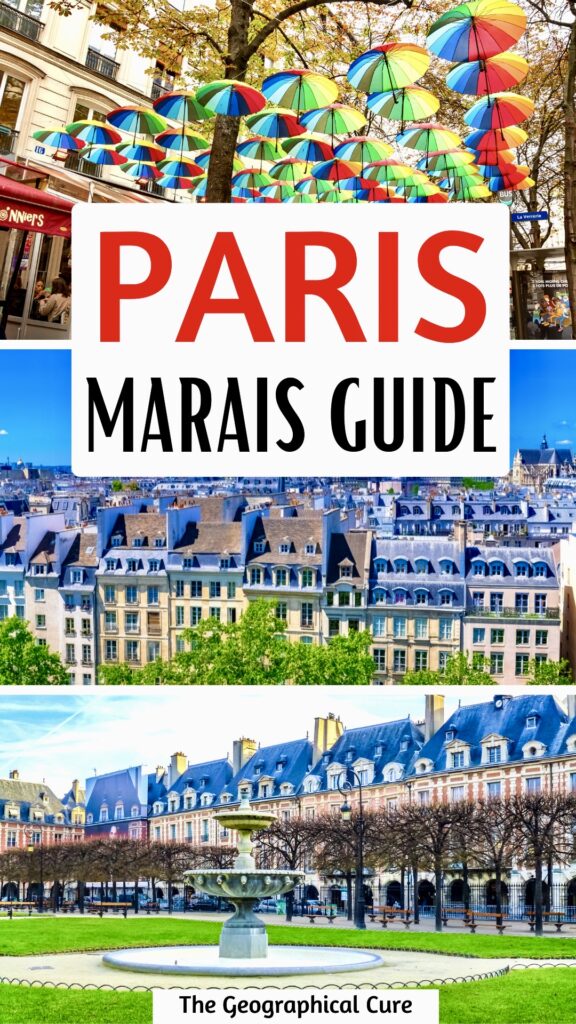The Marais is a beautiful Parisian neighborhood with old world charm. It was untouched by the Haussmann rebuilding frenzy in the middle of the 19th century.
The sheer density of its historical and architectural wealth is amazing, almost overwhelming. Stepping into the disorderly Marais, much like Montmartre further north, is like stepping back in history.
There are footprints of antiquity everywhere you turn. You’re surrounding by the time worn turrets and crumbling majesty of the Marais’ Medieval and Renaissance past.
Historic plaques mark virtually every building. There are elaborate doorways, bas reliefs, and inner courtyards.

The Marais is also loaded with unique boutiques, art galleries, hotspot cafes, and gourmet restaurants. In short, the Marais has it all, making it one of Paris’ most delightful districts.
Snapshot Glance Of Things To Do In Le Marais
- Carnavalet Museum
- Cognacq-Jay Museum
- Eglise Saint-Gervais
- Eglise Saint-Paul
- Hotel de Sully
- Hotel de Sens
- National Archives
- Hotel de Ville
- Le Village Saint Paul
- Marche des Enfants Rouge
- Nicholas Flamel House
- Picasso Museum
- Place des Vosges
- Pompidou Center
- Rue de Rosiers
- Rue Francois-Miron
- Rue de Sevigny
- City Walls
Best Tours In The Maris
Here are some of the top experiences and tours in the Marais:
- food and wine tasting tour
- wallking tour
- walking tour with wine & cheese
- bike tour
- private history tour
Mini History of the Marais
The Marais began life as a swamp, which is the literal translation of its name. Flooded by the Seine, it remained that way until the 13th century.
The district was gradually converted into a residential area. By the late 15th century, the old nobility had taken over the quarter.
In 1605, Henry IV built the elegant Places des Vosges, naming it Place Royale. This spearheaded the development of the Marais into an exclusive neighborhood.
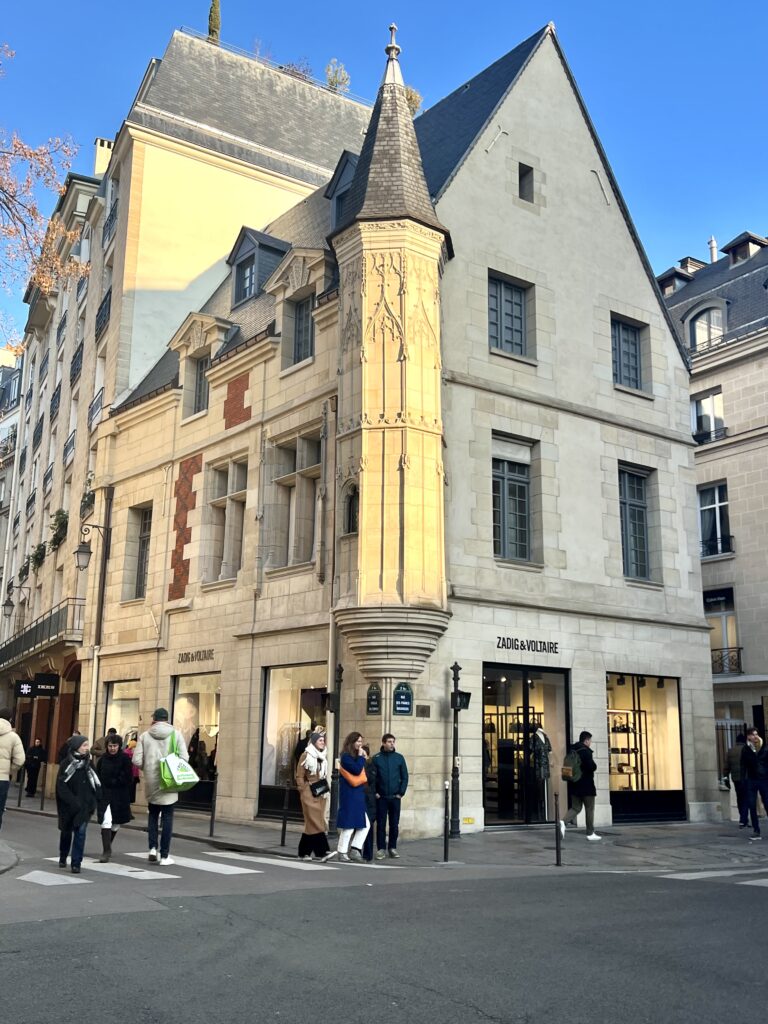
By the 17th and 18th century, the Marais was the aristocracy’s preferred stomping ground. The bigshots left behind dozens of stately mansions, known as hotel particulars.
Many of these stately homes were later bough t by the state and transformed into cultural institutions and museums.
In the 19th century, the aristocrats departed. The Marais became a rather gritty working class quarter. In the 1960s, it began to gentrify.
By the 1980s, the Marais had become the center of gay life in Paris. Real estate prices in the Place des Vosges soared.
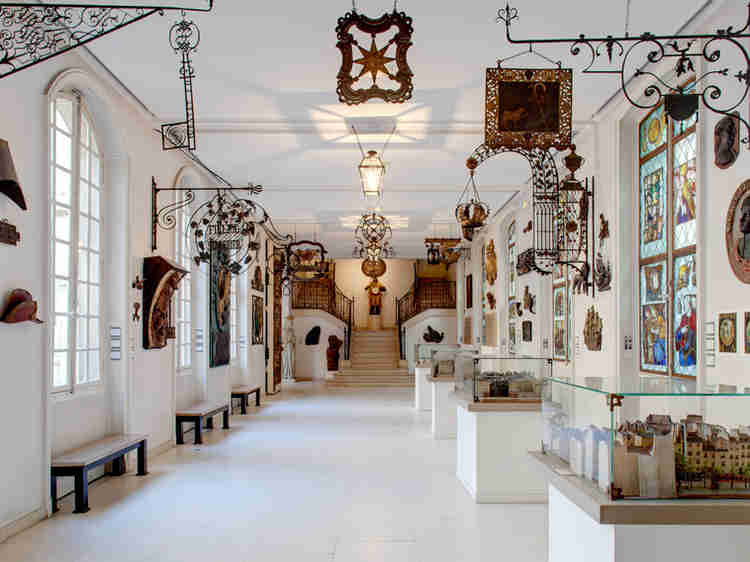
Best Things To Do In The Marais In A Day
1. Carnavalet Museum
History buffs will be enchanted by Carnavalet Museum, “the museum of the city of Paris.” It was Paris’ very first municipal museum, plopped into the center of the bustling and museum-dense Marais neighborhood.
Built between 1548-60, Renaissance architect Mansard reworked the facade and wings. The courtyard is ornamented with bas reliefs depicting the four seasons. A statue of Louis XIV presides in the center, one of the few bronze statues not destroyed by the revolutionaries.
The Carnavalet been listed as a Monument Historique since the mid 1800s. And it’s fabulous, especially after a recent $65 million renovation.
The renovation put the exhibits in a more sensible chronological order, added audio-visual displays, and a new restaurant in the garden.
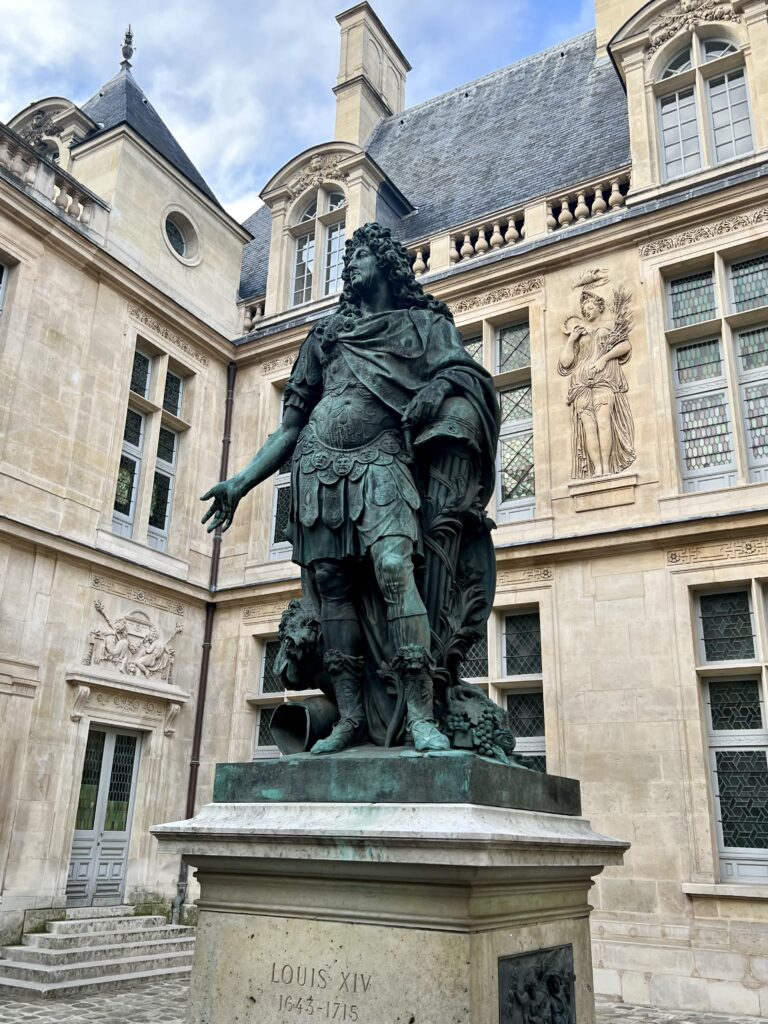
The museum fills two adjacent mansions, the Hotel Le Peletier de St-Fargeau and the Hotel Carnavalet.
One of Paris’ most famous and colorful citizens, Madame de Sevigne, who wrote salacious letters to her daughter, once lived in the Hotel Carnavalet. She was a gifted chronicler and provide insight into French politics and history.
Over 4 floors, the museum documents Paris’ compelling history in an eclectic and eccentric way. Its hodgepodge collection comprises over 600,000 artifacts, making it one of France’s most important museums.
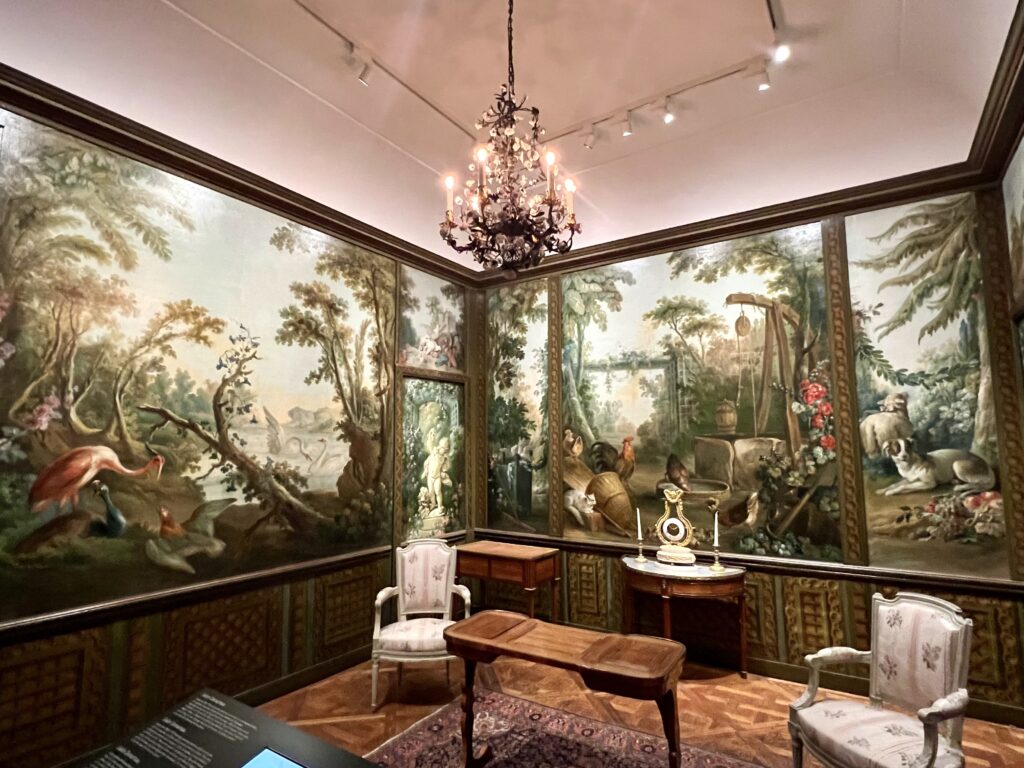
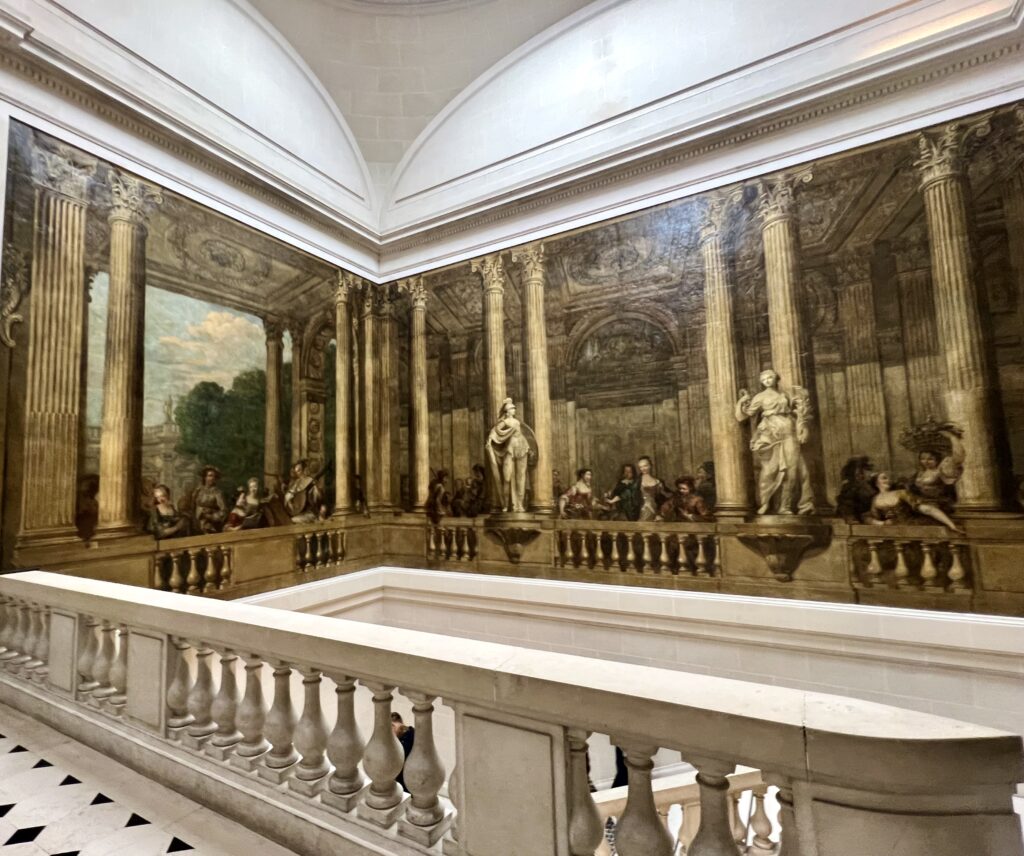
The museum has medieval and Gallo-Roman archeological collections, mementos of the French Revolution, paintings, sculptures, furniture, and other items of art.
Most importantly, the Carnavalet has the world’s largest collection of works on the French Revolution. If you are pressed for time, you should go to this section first.
With its themed period rooms, you can see how the French lived.
Don’t miss Madame Sevigny’s apartments, the Wendell Ballroom, the stunning Demarteau Salon decorated by Boucher and Fragonard, and the Fouquet jewelry shop designed by Alfonse Mucha.
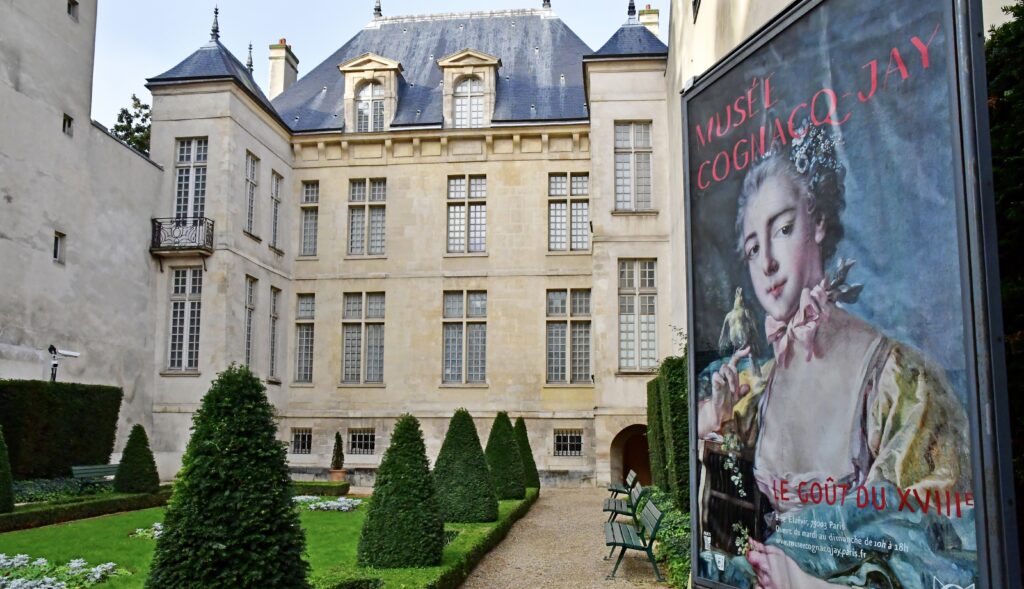
2. Cognacq-Jay Museum
The Musee Cognacq-Jay is a lovely small house museum containing an 18th century collection of 18th century fine and decorative art. You can visit for free.
The collection was assembled by Ernest Cognacq and his wife, who founded the famous Samaitaine department store on Rue de Rivoli. It’s a personal collection that was bequeathed to the city of Paris in 1928.
You’ll find art works by Fragonard, Boucher, Chardin, Reynolds, and Watteau. There’s also a rare collection of bejeweled snuffboxes and period furniture. If you like Rococo art, the museum is definitely worth a visit and you can cover it in an hour or so.
3. Eglise Saint-Gervais
The Eglise Saint-Gervais was completed in 1621 and is a mix of architectural styles.
The facade was designed by Salmon de Brosse, the architect of Luxembourg Palace, and inspired by French Classicism. There are three tiers of columns in the three different Ancient Greek orders. The upper tier is crowned with a semi-circular pediment.
Inside, you should peak at the golden chapel, with its Louis XIII decoration. The church’s organ is the oldest in Paris. Every Saturday, there’s a 30 minute vespers in Latin.
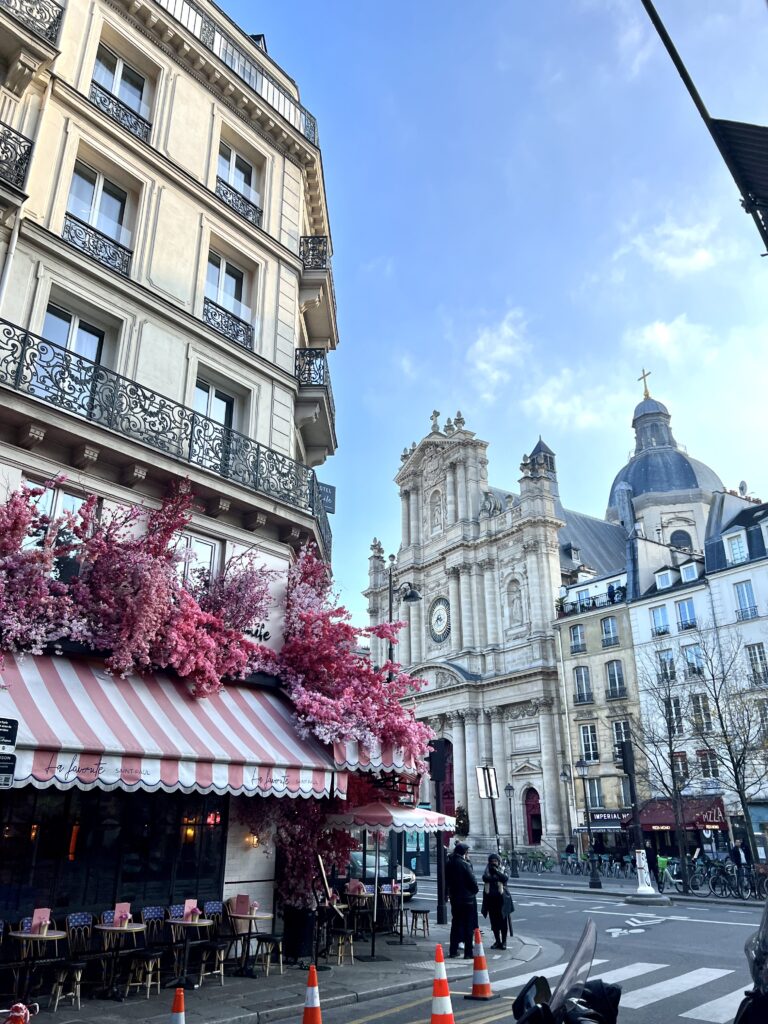
Saint-Paul-Saint-Louis church on rue Saint-Antoine
4. Eglise Saint-Paul-Saint-Louis
This lovely church was commissioned by Louis XIII. Completed in 1641, the king even laid the first foundation stone for the church.
It’s a richly decorated church with a blend of French and Italian Baroque architecture.
It has a three tiered Baroque facade similar to Saint-Gervais. The dome inspired by the Gesù Church in Rome.
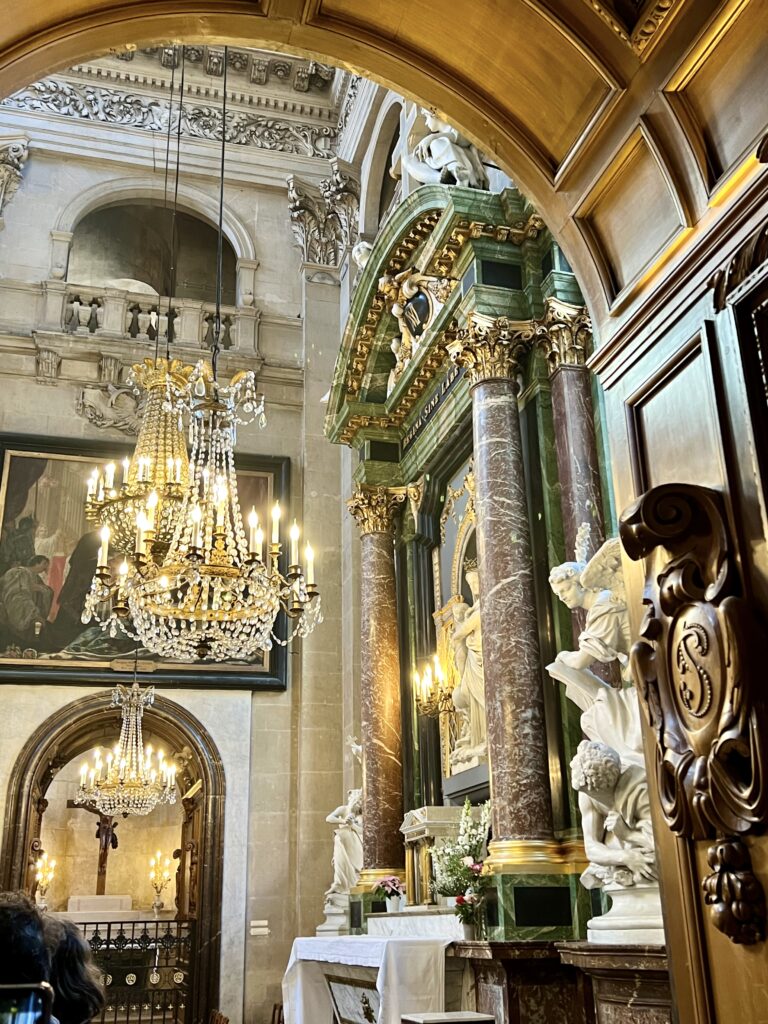
Inside, there’s a an ornate interior with crystal chandeliers. A single nave is flanked by a series of chapels and a wealth of post-French Revolution religious art. The most famous art work is Delacroix’s Christ in Agony in the Garden of Olives.
The church has three organs and the largest one is a classified national monument. The clam shell fonts on the sides of the main door were donated by Victor Hugo.
The church frequently hosts Vivaldi concerts.
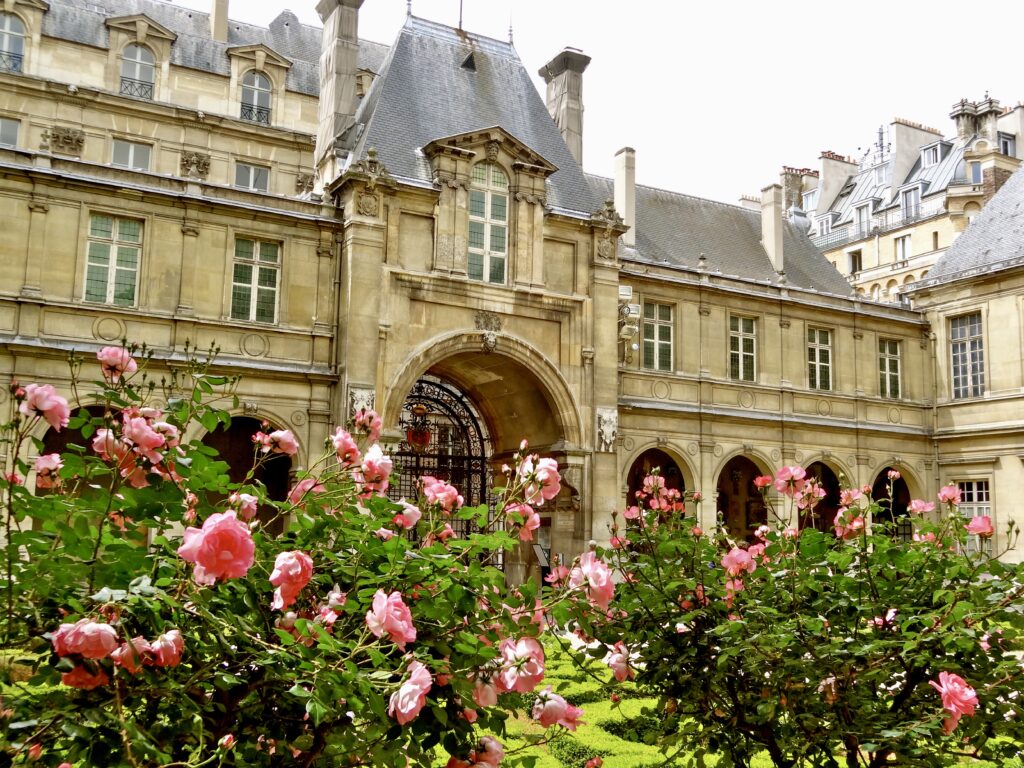
5. Hotel de Sully
The Hotel de Sully is one of Paris’ spectacular Renaissance mansions. It was designed by Jean Androuet du Cerceau and built between 1624-28.
It was once owned by the eminent statesman, the Duke de Sully. The French state purchased the building in 1944 and it now houses the Centre des Monuments Nationaux.
In the center is a three sided courtyard, the cour d’honneur. It’s richly ornamented with allegorical bas reliefs representing the seasons and the elements.
The hotel is not open to the public. But you can visit the bookstore (with a frescoed ceiling) and cross the courtyard and garden during opening hours to access the Place des Vosges.
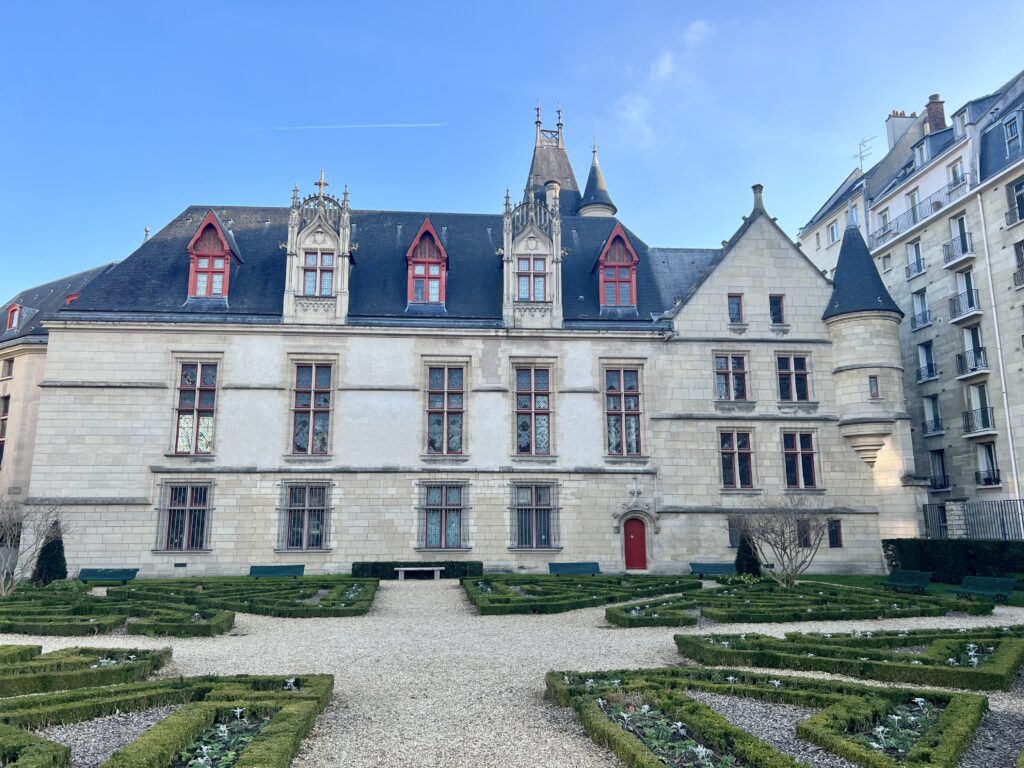
6. Hotel de Sens
Overlooking the Seine, the storybook Hotel de Sens is my favorite medieval building in Paris. It’s one of the few palaces left from that era and one of the best things to do in the Marais.
Although built as a residence, it was nonetheless well fortified with three corner turrets and a keep tower. Its architecture represents the transition between Gothic and Renaissance architectural periods.
In its past, the hotel is most well known for the amorous goings on of Queen Margot, the ex-wife of Henry IV, in 1605. You can still see a bombshell that hit the hotel during the French Revolution.
To the west, you’ll find a formal French garden dating from the Renaissance, which you can access for free. Just push open the green gate.
Inside, you’ll find the impressive Biblioteque Fornay, a public library dedicated to the fine and decorative arts. It’s open daily from 1:00 pm to 7:00 pm except Monday.
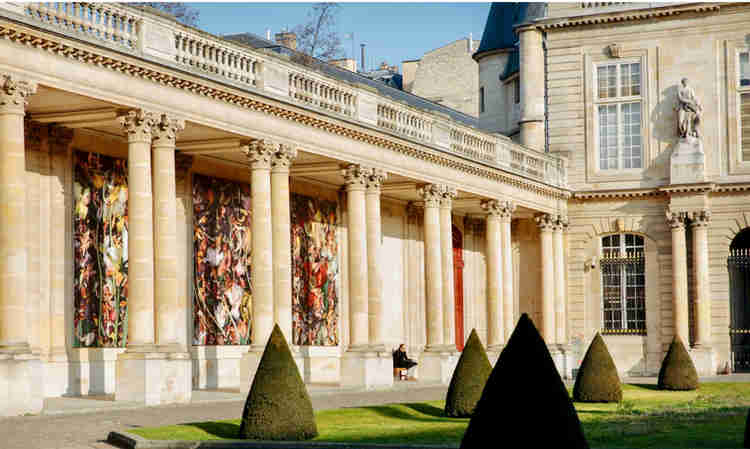
7. Hotel de Soubise | National Archives
The Hotel de Soubise is home to France’s National Archives, with historic documents dating back to the 5th century. It’s free to visit and crowd-free.
The hotel is the most sumptuous of the Marais mansions bought by the state, with an astonishingly large courtyard. It has a richly sculpted facade with paired columns and a balustrade.
Set amid a Rococo interior, it houses permanent and temporary exhibitions of important national documents. Among other things, the archives house Marie Antoinette’s last desperate letter, written from the Conciergerie, before she was guillotined on the Place de la Concorde.
The gardens area also beautiful. You enter them to the right of the main entrance for the museum.
READ: Guide To Marie Antoinette Sites in Paris
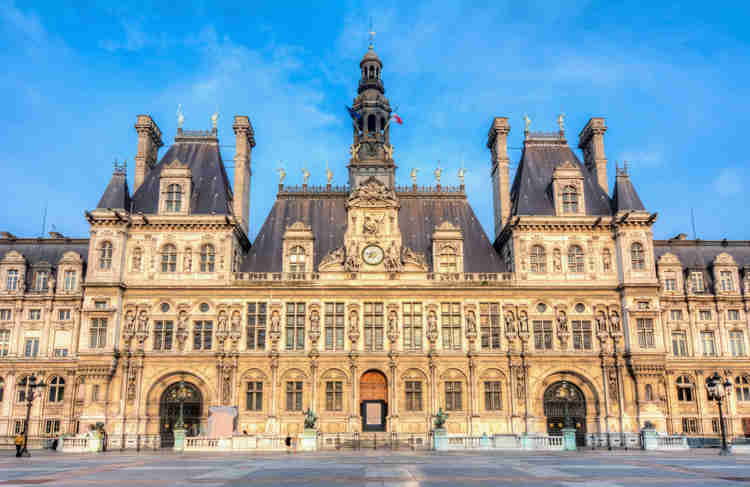
8. Hotel de Ville
Hotel de Ville is Paris’ city hall. The building has been the seat of the City Council since 1357.
It was destroyed by a fire in 1871 set by French Commune extremists, but rebuilt in its original Renaissance style in the late 19th century. It looks more like a chateaux than a government building.
Hotel de Ville is one of Paris’ most grand Renaissance buildings. It’s decorated with hundreds of statues of famous Parisians. The central tower has a giant clock.
You can’t go inside the building, except on a special occasion or heritage day.
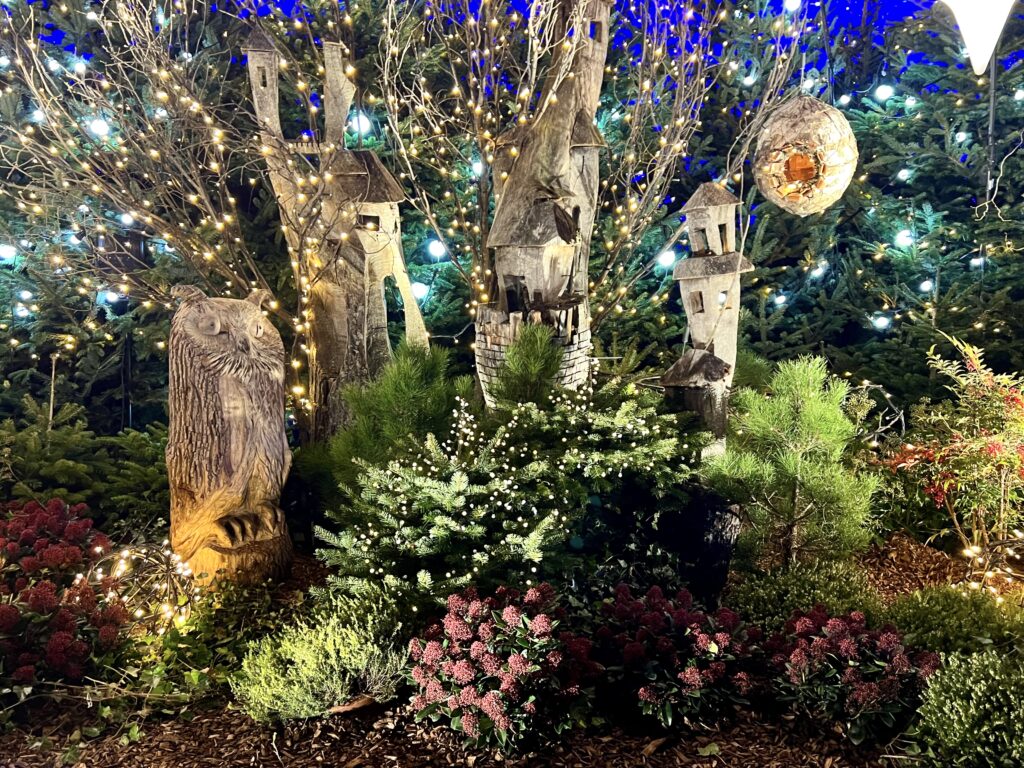
But you can stroll in the pedestrianized square and admire the beautiful facade. The square is where Robespierre was shot and arrested after his reign of terror.
During the holiday season, the building is lit up with a different theme each year. In 2022, it sparkled and turned bright blue. And there’s an ice skating rink for kids.
You will also find one of Paris’ best Christmas markets. I thought it was the most tasteful one I visited in Paris, no kitsch just beautiful decorations.
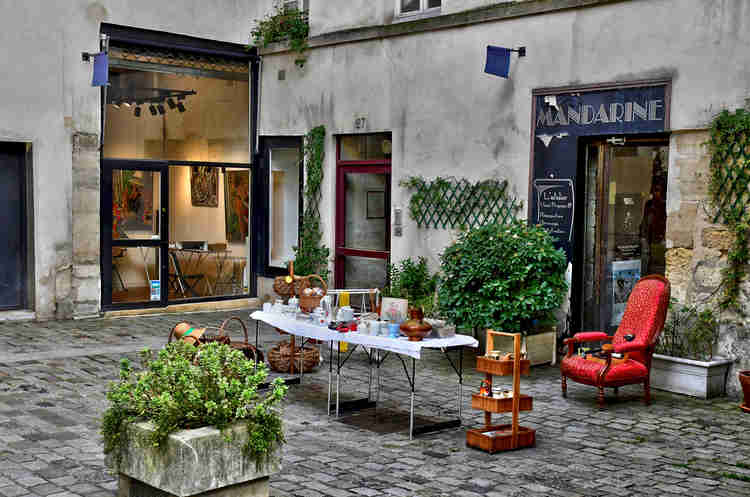
Village of Saint Paul
9. Le Village Saint Paul
Tucked behind the Church of Saint Paul and Saint Louis, Le Village is a bit of a hidden gem in Paris for tourists.
It’s a little warren of cobbled lanes and back passages. They’re filled with over 80 antique shops, vintage stores, and cafes.
There are signs pointing to it, and yet it’s still easy to miss. It’s tucked away behind the Église Saint-Paul-Saint-Louis. A secret lane leads you into a a maze of covered passageways.
Artists and artisans offer up their wares. In the summer, the shops move outside.
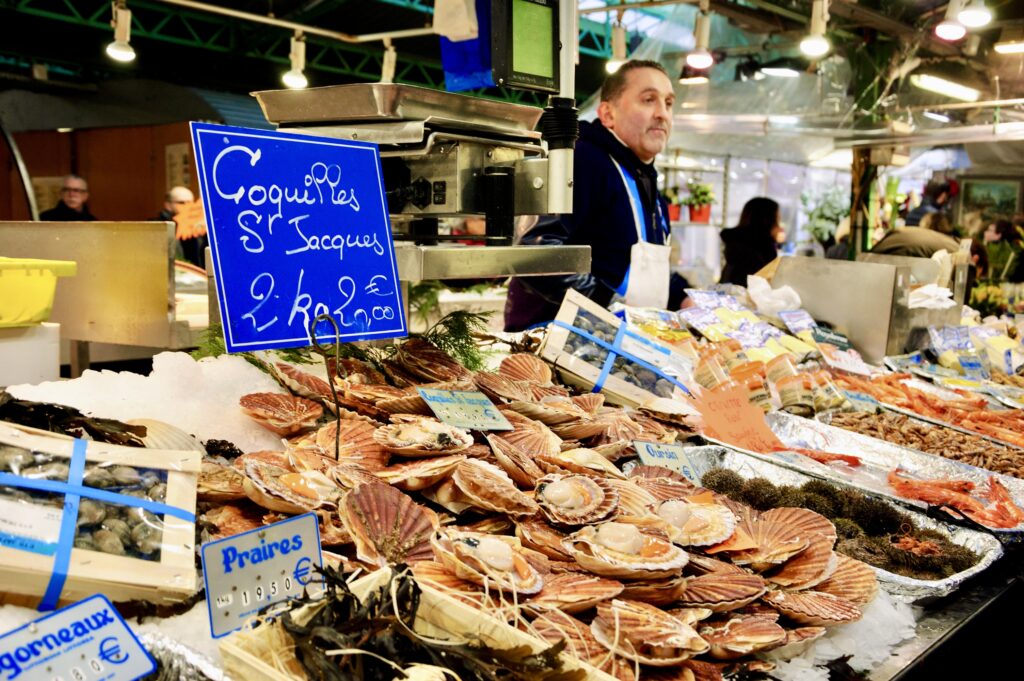
10. Marche des Enfants Rouge
The Marche des Enfants Rouge is a 17th century covered market off the Rue de Bretagne. The oldest market in Paris, it specializes in organic produce and wines.
It has myriad fresh fruit, vegetable, and meat stands, as well as some popular restaurants like Bibo Vino. There’s even flower shops.
It’s the perfect spot to stop for lunch or to get groceries in the Marais.
11. Nicholas Flamel’s House
Down a winding cobbled road, you’ll find a rather unusual stone house dating from 1407 and covered in symbols. It’s officially the oldest house in Paris. Now, it’s the site of a restaurant and hotel.
But the house was originally built by Nicolas Flamel, who legend holds was a famous alchemist.
Flamel reputedly invented the Philosopher’s Stone, a mysterious object that turned metal into gold. But he’s a real person, not just a Harry Potter or Victor Hugo character.
Flamel conducted his experiments in this house. It’s never been definitively proven that Flamel practiced the dark arts. But he’s certainly been the subject of obsession.
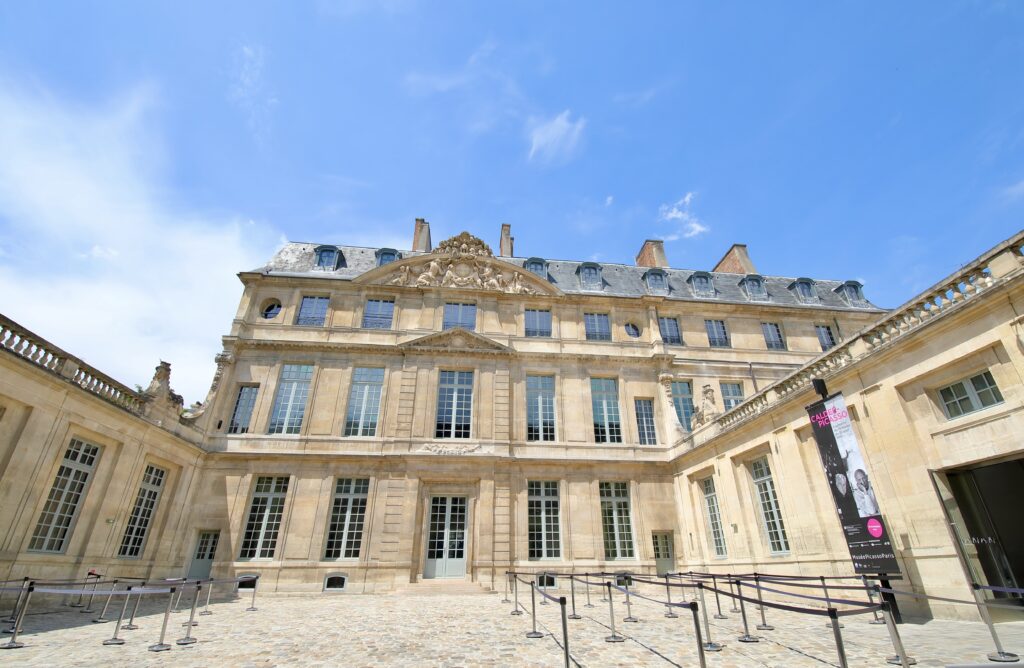
12. Picasso Museum
Ah, I adore Paris’ Picasso Museum. The eponymous museum is housed in the gorgeous Baroque Hotel Sale. For art lovers, it’s definitely one of the best things to do in the Marais.
The museum houses the world’s largest collection of Picasso works. It’s Picasso’s personal collection, the art he never parted with in his life.
Picasso liked to joke that he was the “greatest collector of Picassos.” His heirs donated the works to the French state to avoid taxes.
The intimate museum represents all the artistic periods of his life, all the women he loved, and reveals his extraordinary range and talent.
The museum is organized chronologically. As you stroll, you’ll see the evolution of his artistic styles and the succession of his long-suffering female muses — Fernande Olivier, Olga Khoklova, Dora Maar, Marie Therese-Walter, Francoise Gilot, and Jacqueline Roque. His art and his loves were always intertwined.
The Picasso Museum is an incredibly popular museum in Paris. To see it and avoid lines, you need to book a skip the line ticket. Entry is also included in the Paris Pass.
You can also book a 2 hour small group guided tour or a 2 hour skip the line private tour of the museum.
READ: Guide To Picasso Museums in Europe
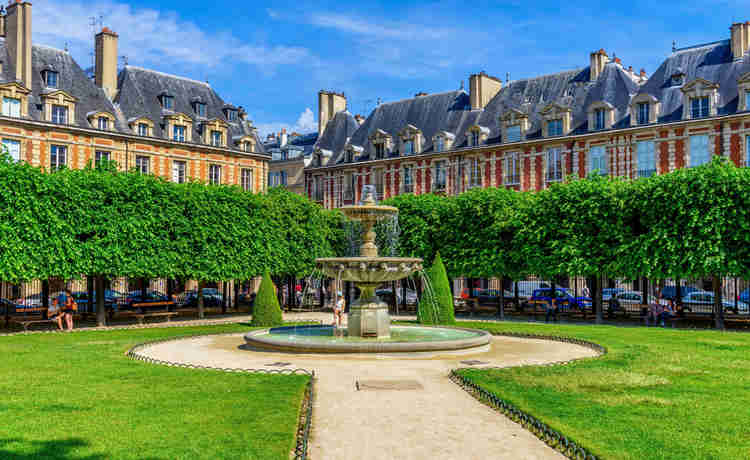
the beautiful Place des Vosges
13. Place des Vosges
The Place des Vosges is perhaps the top attraction in the Marais and one of the most beautiful places in all of Paris.
The grand square was the brainchild of King Henry IV and inaugurated by Louis XIII in 1612, who moved in with his Queen Anne of Austria. Originally called the Place Royale, it’s now the oldest square in Paris.
The aristocracy followed the king’s lead, building the grand mansions that rim the square and imbue it with glamor. They are a perfectly symmetrical vision of rose-toned brick and stone with steep sloping roofs, dormers, and arcaded passageways.
At No. 6, you’ll find the home of Victor Hugo, which served as the prolific writer’s pied-à-terre. He moved to the Place des Vosges when he was 30, after publishing his wildly successful novel The Hunchback of Notre Dame and began writing Les Miserables.
Today, his home, the Maison Victor Hugo, is a museum decorated by the great man himself. It’s meant to give visitors a sense of what Hugo’s daily life was like.
Thematic rooms are arranged with furniture and works of art that Hugo created or collected. You’ll see first editions of his books, family portraits, photographs, sheet music, 350 drawings by Hugo, and a bust sculpted by Rodin.
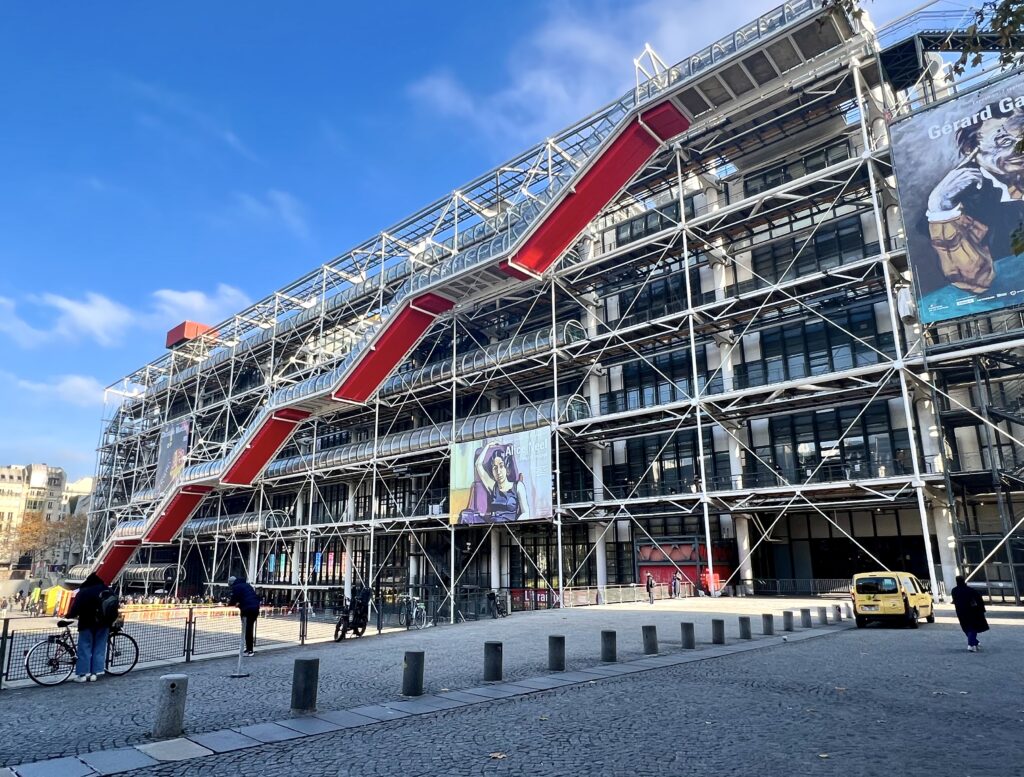
14. Pompidou Center
The Pompidou Center is Paris’ modern art museum. It’s one of the best things to do in the Marais, located in the lively Beauburg neighborhood.
Opened in 1977, the Pompidou is known for its radical “inside out” architecture, designed by Renzo Piano. Within the guts of this exoskeleton lie 120,000 works of art.
The Pompidou has Europe’s best and most important collection of the Golden Age of modern art, from Fauvism to Pop Art. You’ll find works by Kandinsky, Rothko, Picasso, Pollack, Miro, Klee, Matisse, and Modigliani as well as contemporary masters.
Some of the must see masterpieces include Marcel Duchamp’s Fountain, Louise Bourgeois’ Precious Liquids, Andy Warhol’s Self-Portrait in Drag, Jackson Pollock’s Number 26 A, and Picasso’s The Guitarist and Harlequin.
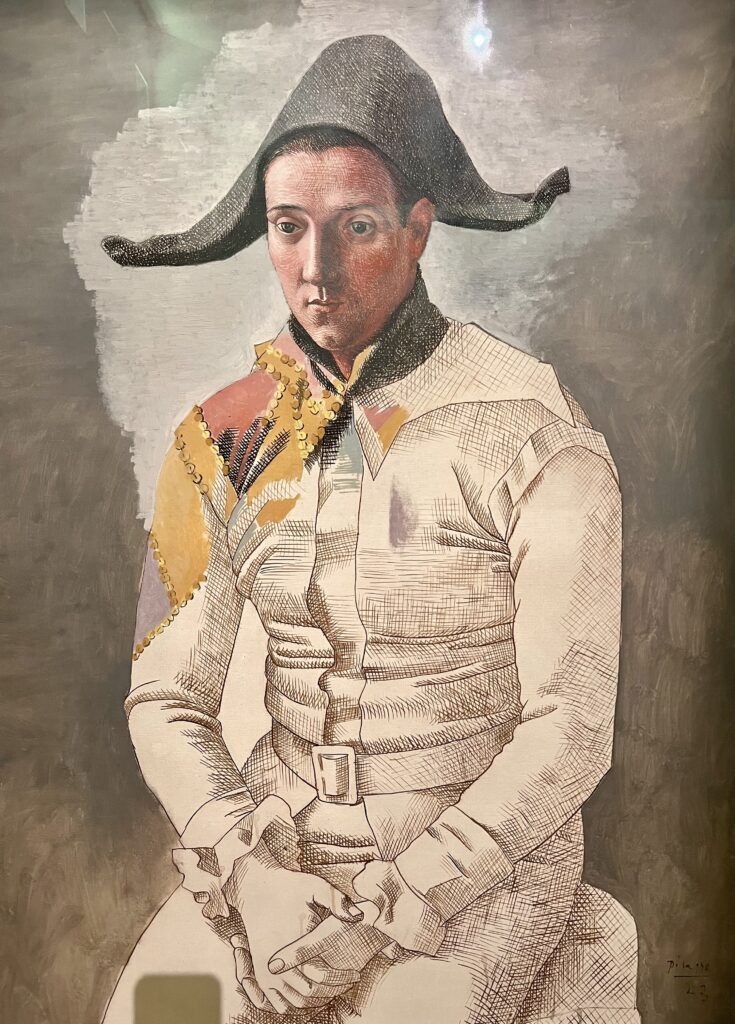
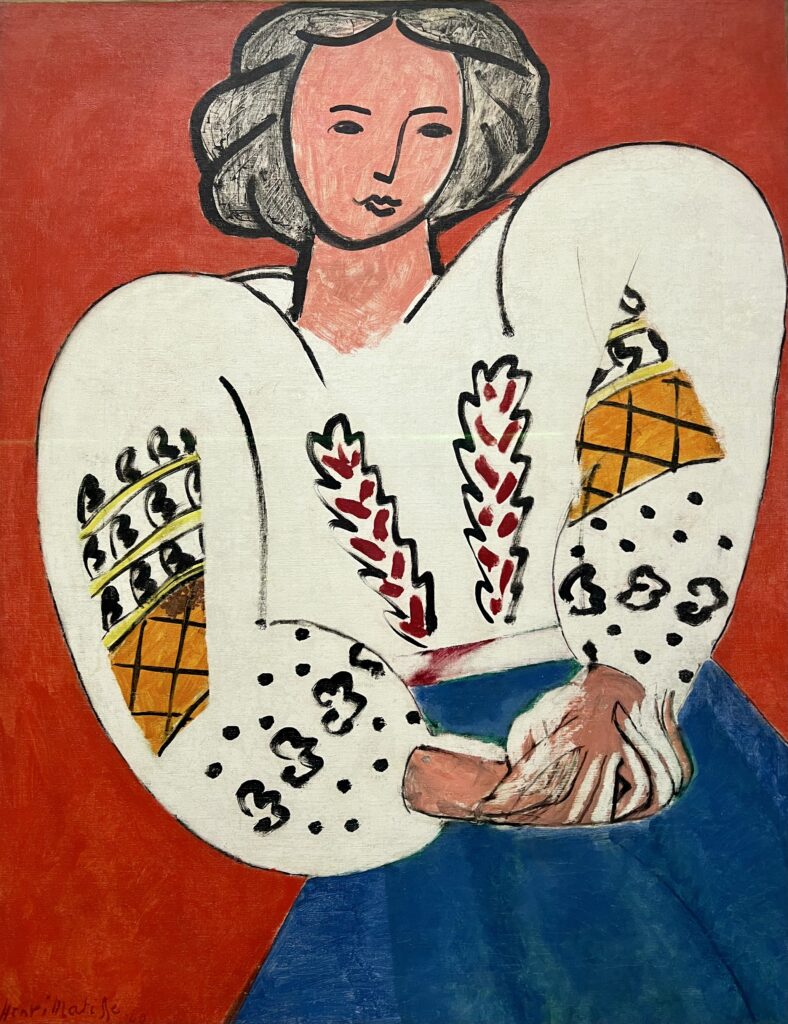
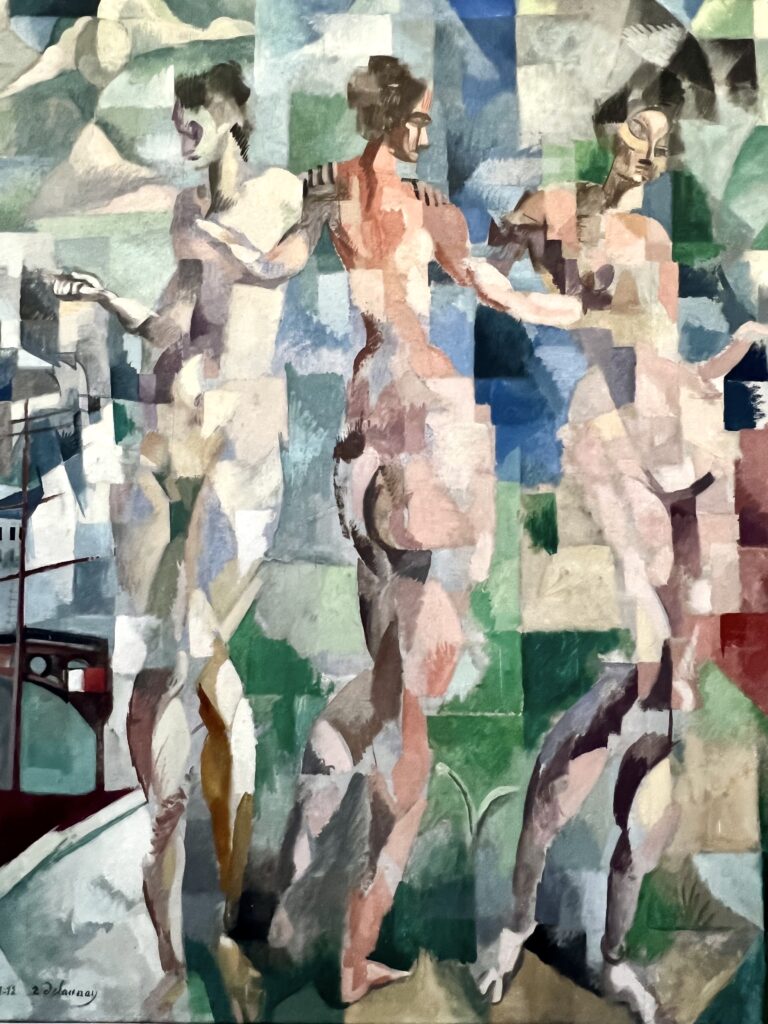
But you’ll also see all forms of media, from installations to photography to experimental film. Don’t miss the spectacular views of Paris from the sixth floor, which doubles as an exhibition space and is home to the St. George restaurant.
You can also visit Brancusi’s studio, reconstructed by Piano. It’s in a separate space across from the main entrance.
Romanian by birth, the sculptor Constantin Brancusi lived most of his life in Paris. Upon his death in 1956, he gifted the entire contents of his studio to the French state. The studio is a work of art in its own right and is free to visit.
You’ll want to pre-book a skip the line ticket or be prepared to wait in line. The Pompidou Center is scheduled to close for a multi-year renovation after Paris hosts the Olympic Games in 2024.
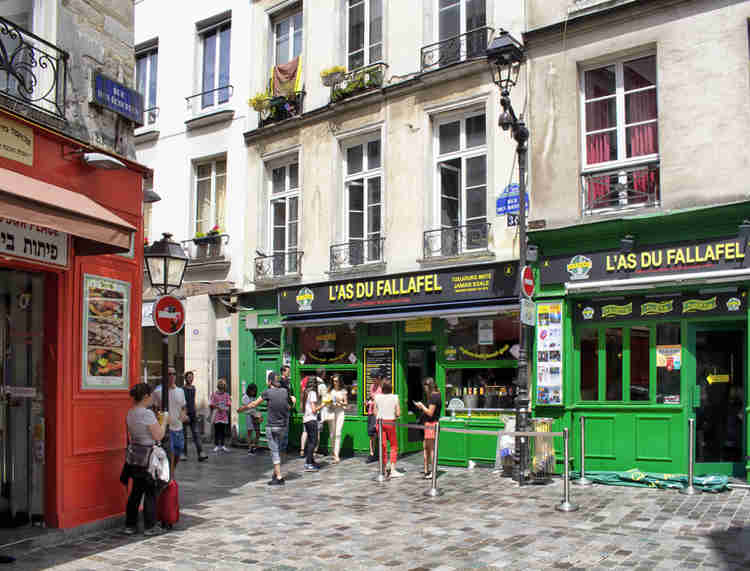
15. Rue de Rosiers
The pedestrianized Rue de Rosiers is the heart of the medieval Jewish Quarter in the Marais. It’s a buzzing urban village and the epicenter of Marais hipness.
It’s home to plenty of falafel shops, where you can eat in or take away a delicious and inexpensive meal. This is one street in Paris where it’s perfectly acceptable to eat as you stroll.
By far the most popular one is L’As due Fallafel, where you’ll always find a line. They have the best falafel sandwiches, chickpea fritters, and harissa.
Korcarz is an excellent boulangerie on the street. You can nibble on pastries, and sip coffee in an old-fashioned bakery with sidewalk tables.
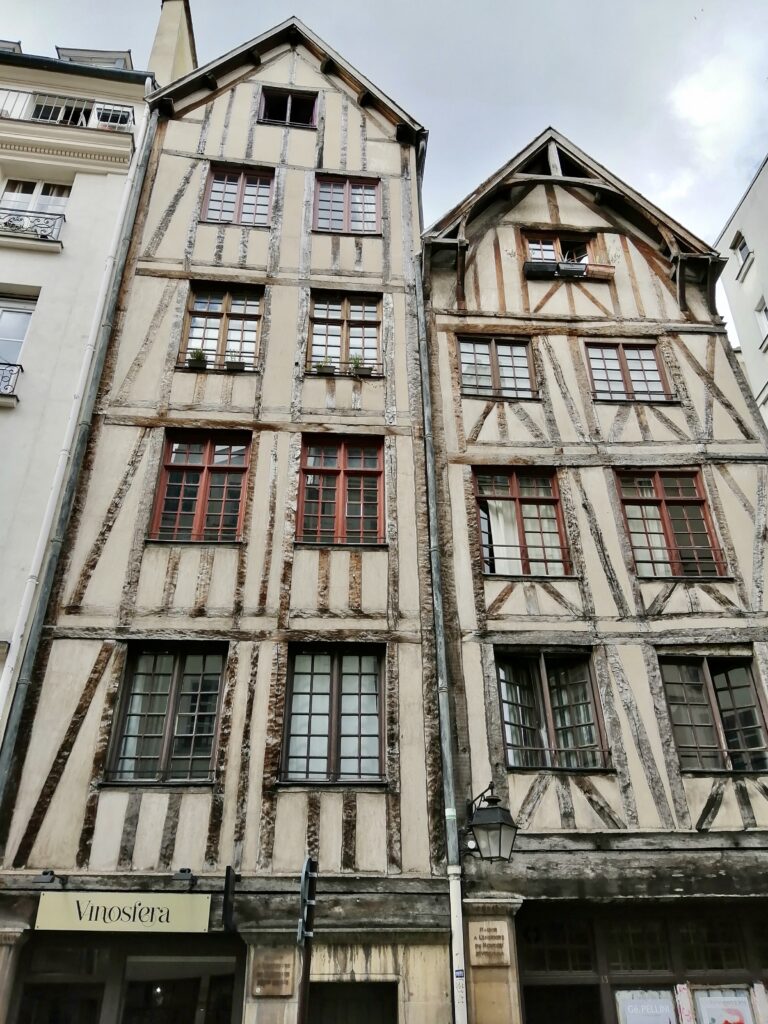
16. Rue Francois-Miron
At # 11 and 13, Rue Francois-Miron is home to an astonishing site — two medieval houses with exposed timbers, a rarity in Paris. They date from the 14th or 15th century. They are known as the House of the Reaper and the House of the Sheep.
You should also inspect the Hotel de Beauvais, which has been restored to its original splendor. It has an innovative design with the courtyard facing the street reminiscent of an opera house. That way, the residents could watch people and parades go by.
In 1763, Mozart stayed here when he came to dazzle the court at Versaille.
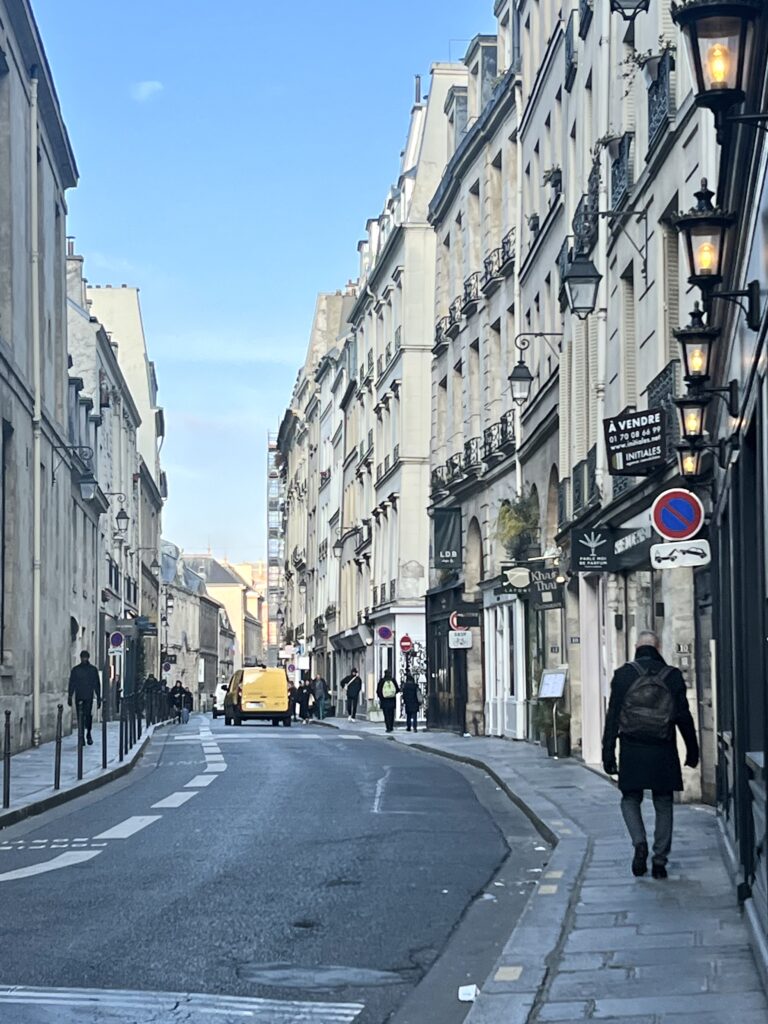
17. Rue de Sevigny & Rue Francs-Bourgeois
Rue de Sevigny and Rue Francs-Bourgeois are two of the main arteries in the Marais.
Rue de Sevigny is one of the prettiest streets in the Marais. The street is named for the marquise de Sevigne, who I mentioned resided at the Musee Carnavalet and is France’s great lady of letters.
Rue Francs-Bourgeois is a trendy and stylish shopping street filled with cafes and clothing boutiques. It’s great for people watching and won’t break your budget like Rue St. Honore.
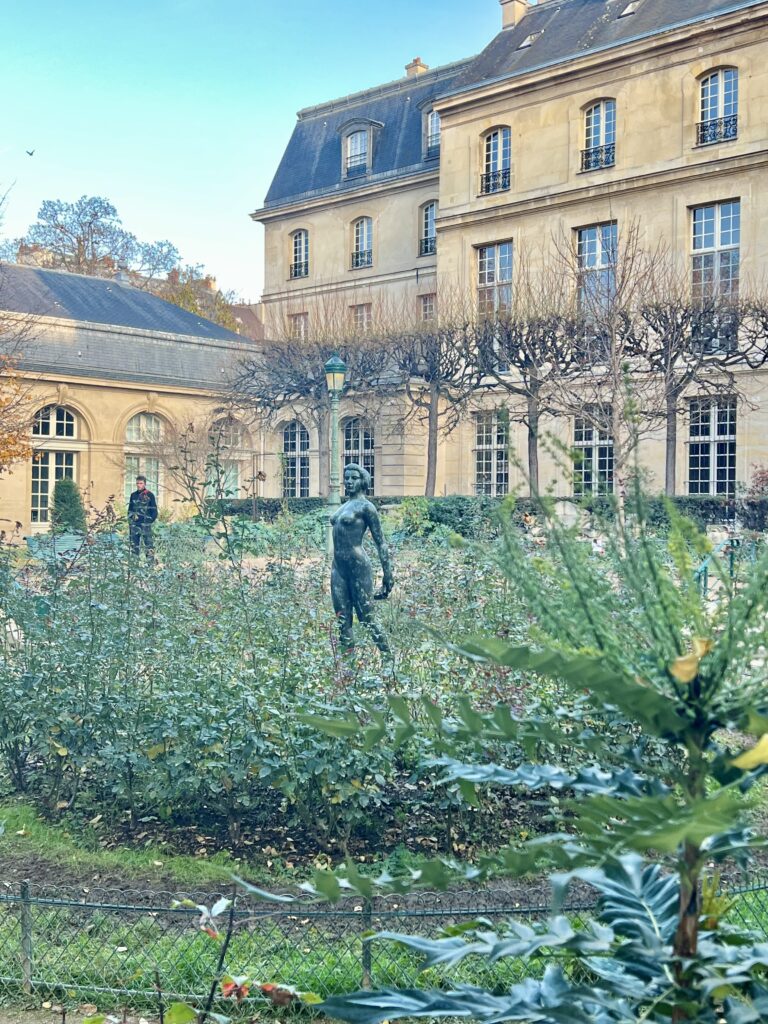
18. Quaint Squares
The Marais is home to some cute squares where you can relax and picnic.
Square George Cain is a splendid small park with ruins and monuments. It is home to the Stone Museum of Paris, a cemetery for stones. In the center is a beautiful bronze 17th century statue of a nude woman in the middle of a rose bed, L’Aurore.
Place du Marche Ste.-Catherine is a charming square. It was once home to an 13th century Augustinian priory. You’ll find a couple shops and cafe.
The Square du Temple is a lovely garden park, built on a former fortress of the Knights Templar.
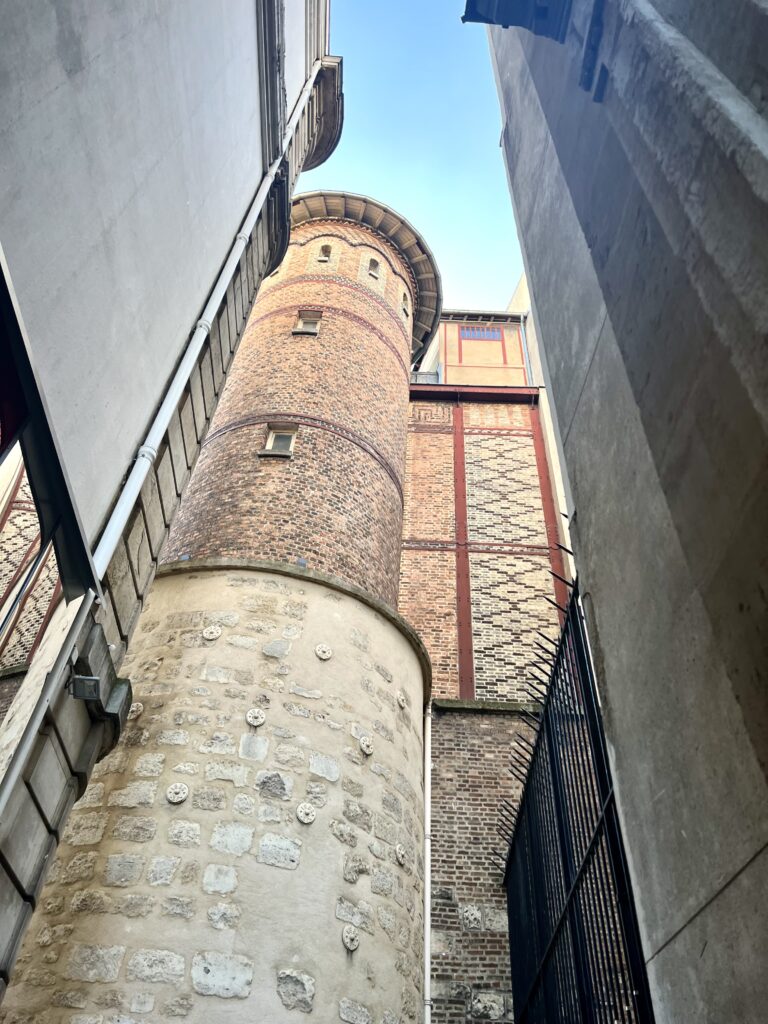
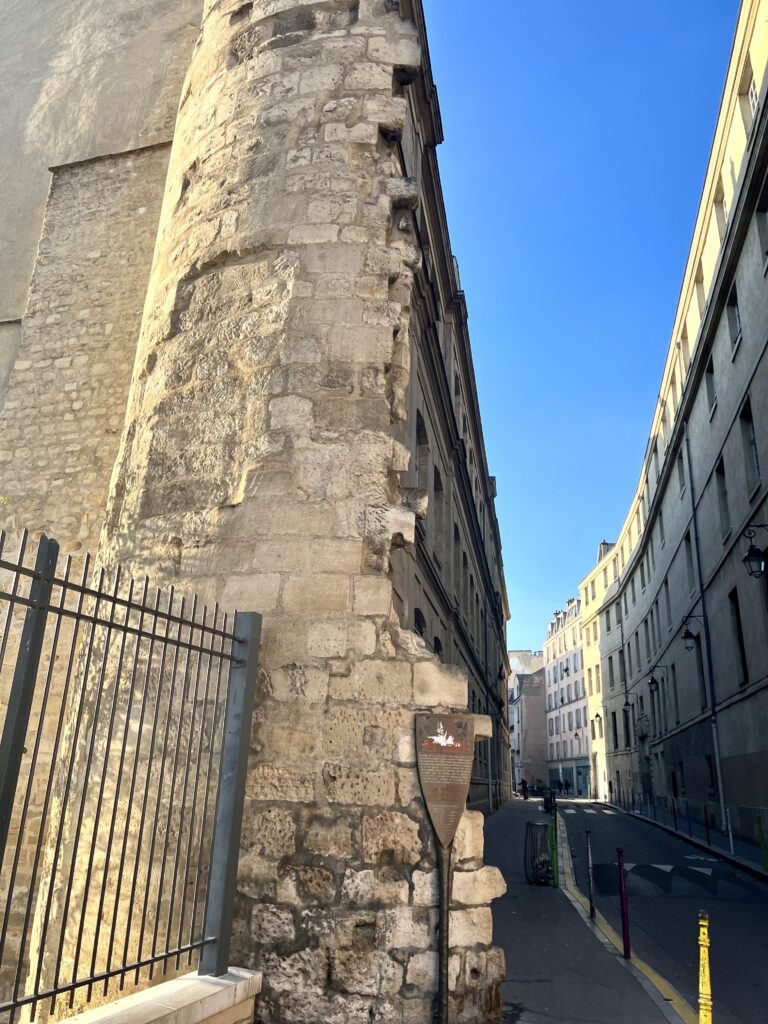
19. Remnants of City Walls Of Phillippe August
Down a lane in a courtyard off Rue Francs-Bourgeois, you’ll find a vestige of the city wall. It was built between between 1190 and 1220 by Philippe-Auguste.
The tower you see is a recent addition, but the original base is still visible. It was only saved by the intervention of Victor Hugo.
There is another impressive section of wall along Lycée Charlemagne. This is the longest conserved part with two towers and some traces of crenellations.
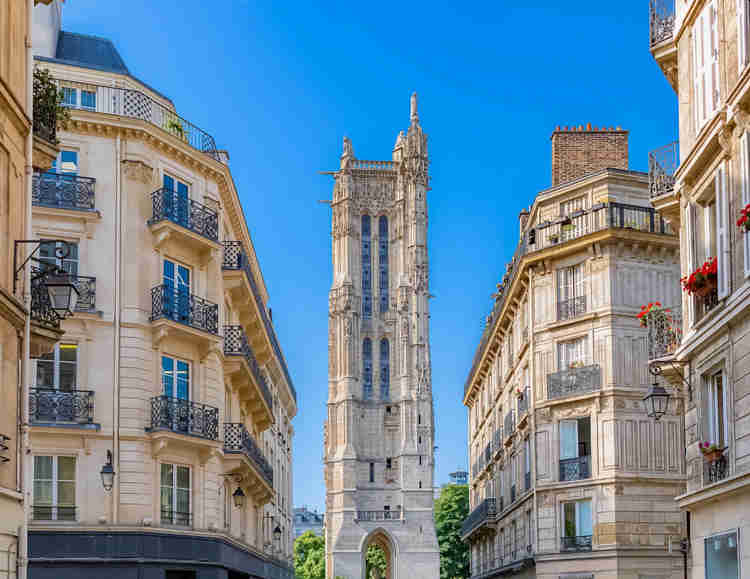
Other Attractions Near the Marais
There are some other sites worth visiting that are within easy striking distance of the Marais.
1. Tour Saint-Jacques
The Tour Saint-Jacques is flamboyant Gothic style tower, built between 1509-23. It’s the only remaining vestige of the Saint-Jacques-de-la-Boucherie Church, which was destroyed in 1797 during the French Revolution.
Today, it’s listed as a National Historic Landmark. For €12, you can climb the tower on a 40 minute guided tour every hour from 10:00 am to 5:00 pm on Friday through Sunday. Tours last for 40 minutes and it’s 300 steps to reach the top.
This is a surprisingly popular activity. If you want to climb the tower, my guide told me it books up months (yes months!) in advance. If you can’t get a ticket, you can admire the facade from the leafy square it sits in.
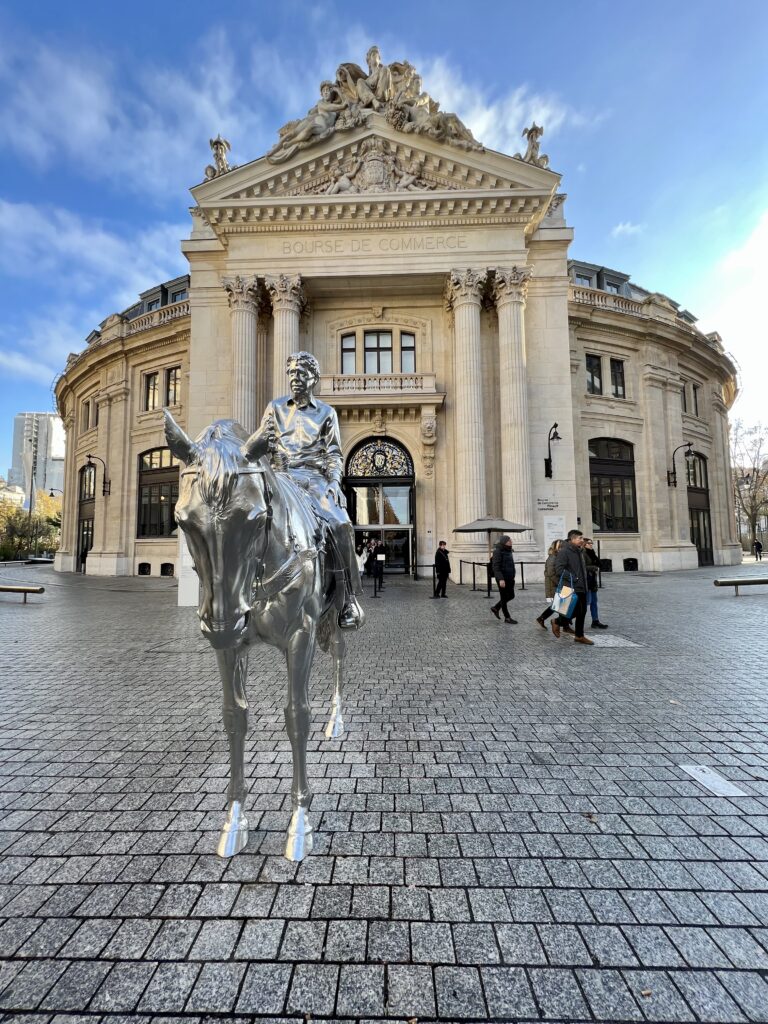
2. Bourse de Commerce
The Bourse de Commerce is Paris’ hot new museum, opened on May 2021. It houses the collection of French billionaire Francois Pinault in a beautifully renovated building.
The private museum was overhauled and renovated by prize winning architect Tadao Ando, to the tune of $140 million. It has 3,000 square feet of exhibition space.
Pinault’s collection of contemporary art includes 5,000 works by Cy Twombly, Cindy Sherman, Damian Hirst, and Jeff Koons. There are also special exhibitions.
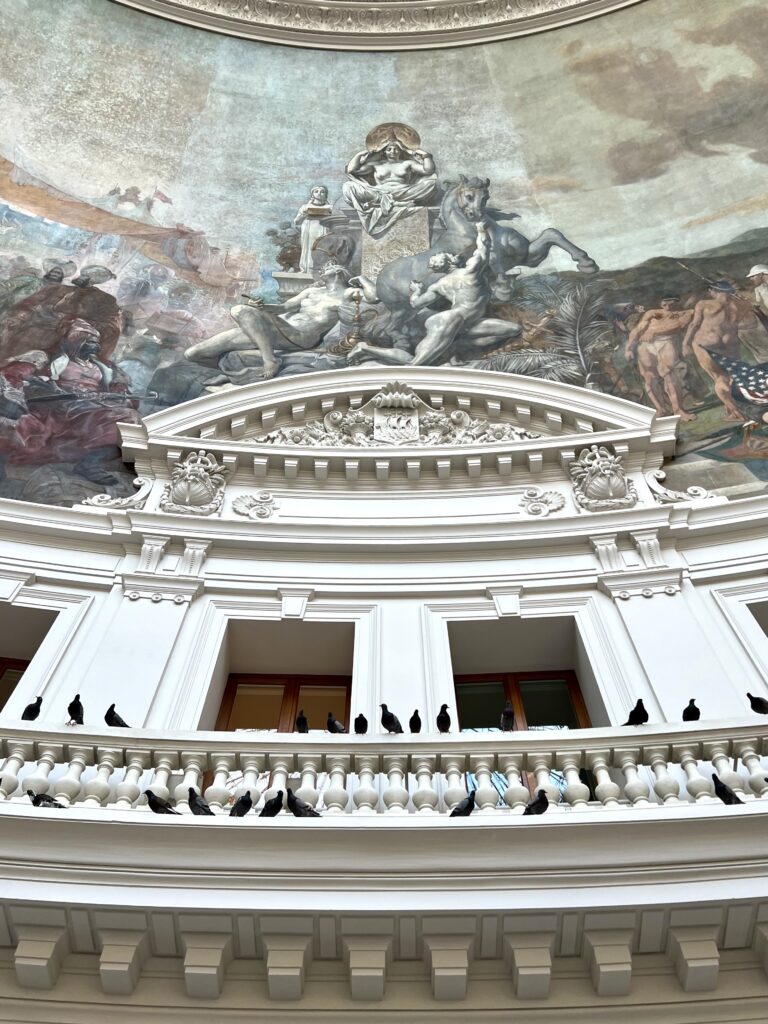
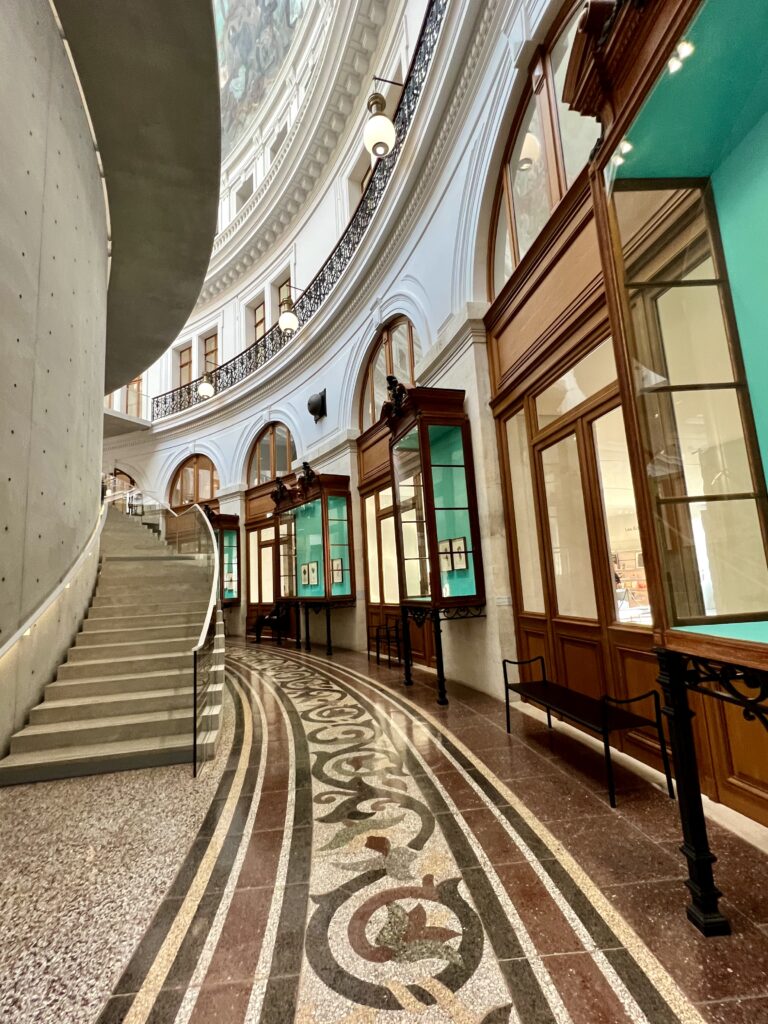
The central hall is astonishing. It’s ringed with frescos and topped with a glass dome. There are some whimsical touches. In one spot, you can see Maurizio Cattelan’s pigeons on the cupola balconies.
Definitely head up to the top floor. It overlooks the Jardin Nelson Mandela and offers up views of Saint-Eustache church, the Centre Pompidou, and Paris rooftops.
Here’s my complete guide to the Bourse de Commerce. Click here to book a skip the line ticket.
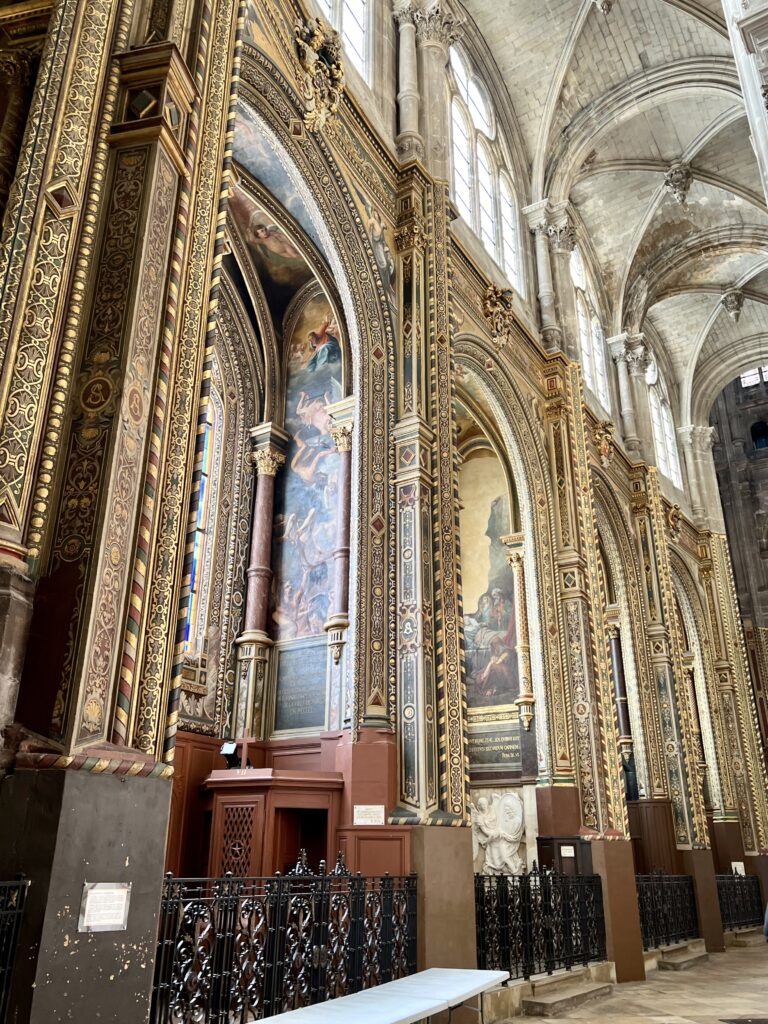
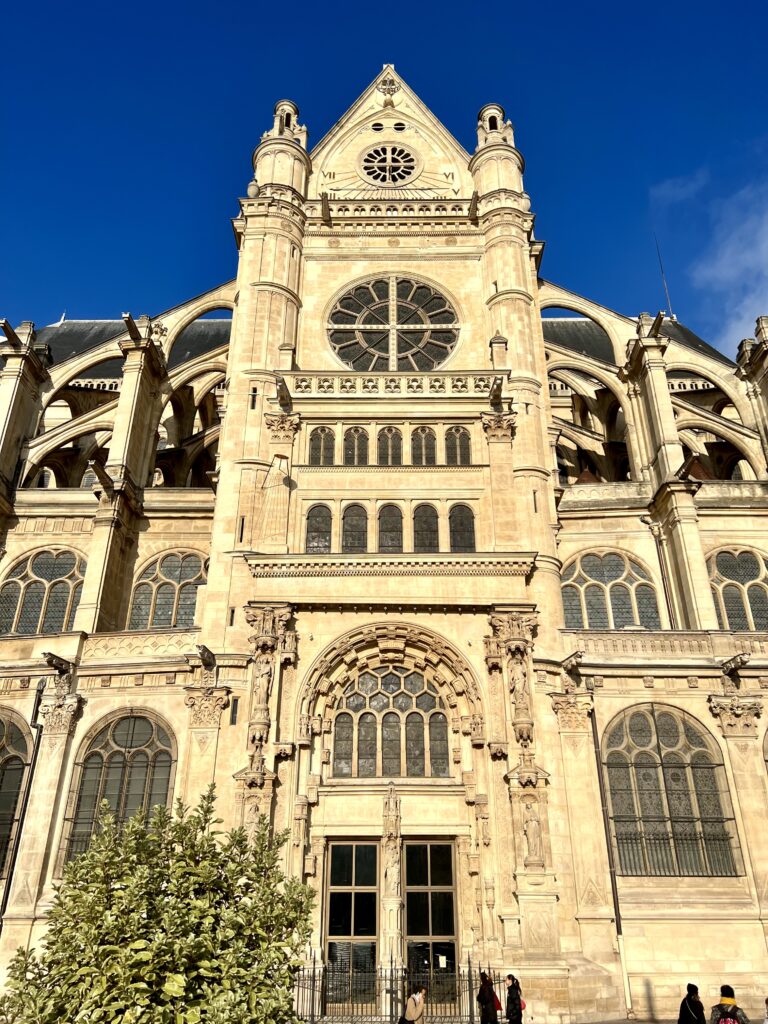
3. Saint Eustache Church
Saint Eustache Church is right next to the Bourse de Commerce and definitely worth a visit.
It took 100 years to build, constructed between 1532 and 1632. It was the last Gothic church built in Paris.
The outside looks late Gothic, with thrusting gargoyles on the facade. In contrast, the inside is Renaissance, built and restored in different centuries.
You’ll find intricate gilded and painted columns, pendentive vaulting, some original stained glass, and a grand 8,000 pipe organ on the back wall. There are organ recitals on Sundays from 5:30 pm to 6:00 pm.
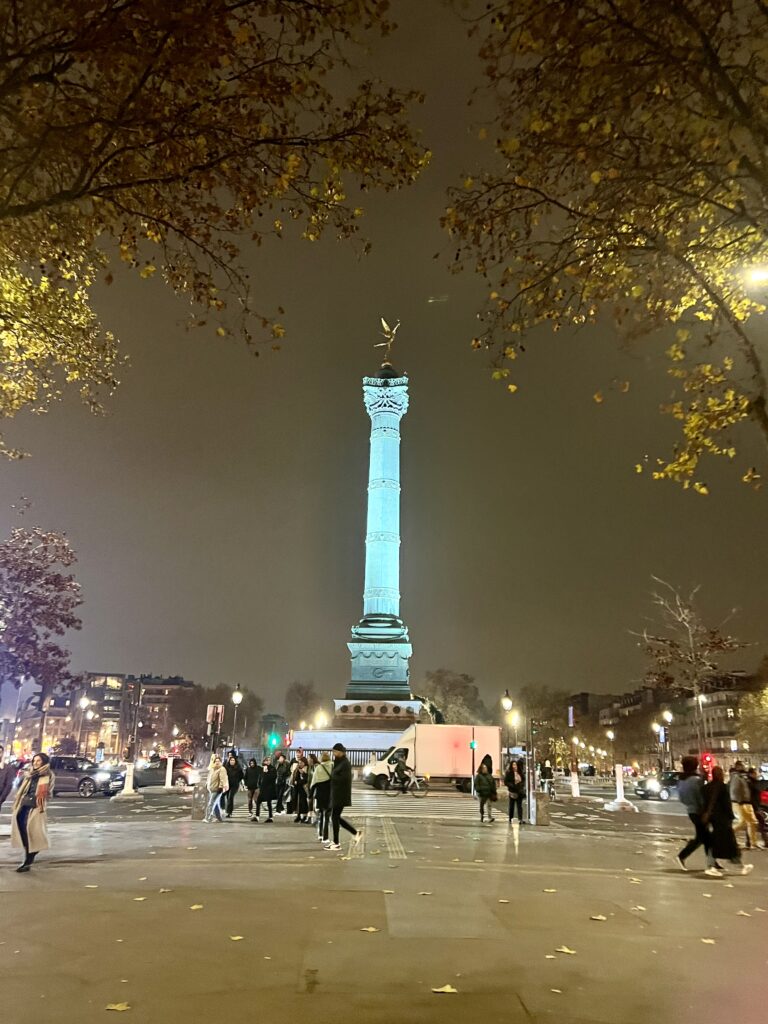
4. Place de la Bastille
The Bastille was once a royal fortress and prison with 8 towers and curtain walls. In 1789, French revolutionaries demolished the building, which symbolized the tyranny of the Bourbon monarchs.
Hence, nothing remains of the original Bastille fortress, except the cobblestoned outline on the pavement that gives you an idea of the vast size of the building.
Today, in the center, is the July Column, the Colonna de Juillet. Constructed by Louis Philippe, it’s a 155 foot tall memorial to the storming of the Bastille and the subsequent revolt of 1830. It was inspired by Trajan’s Column in Rome.
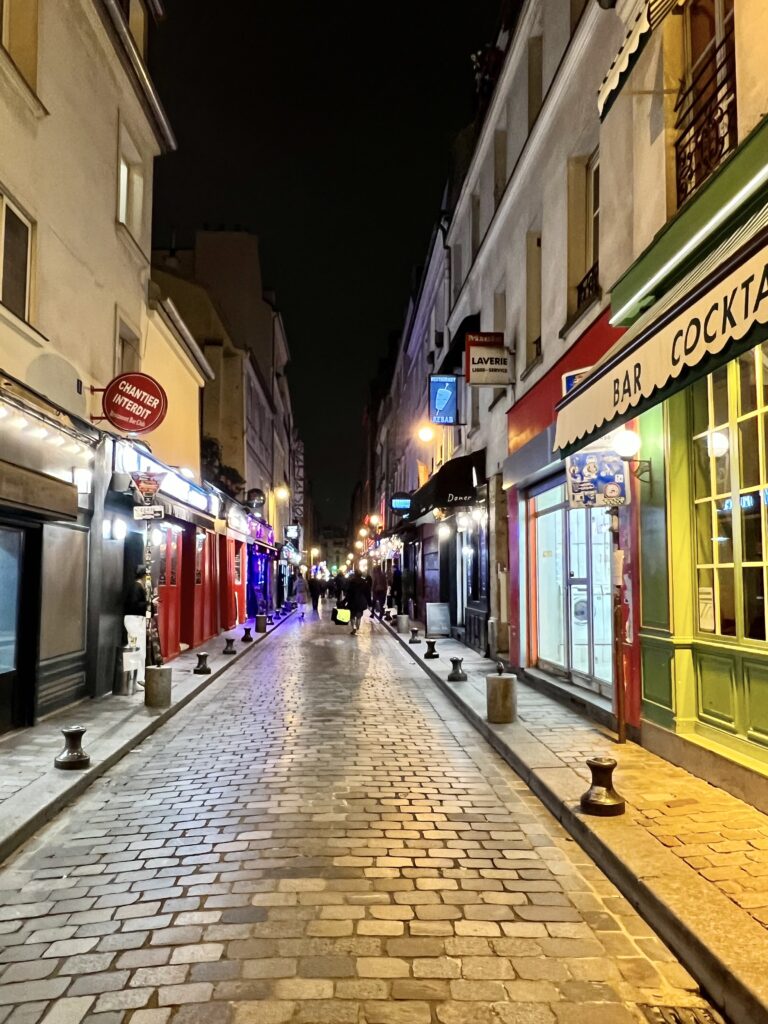
The column is engraved with the names of those who died in the French Revolution, and the remains lie in a gallery below. At the top is the Genie de la Liberte, which means spirit of freedom.
The Bastille is is a lively place for nightlife, particularly on the Rue de Lappes. It’s also the location of the Opera Bastille, which is Paris’ main opera venue with wonderful acoustics.
Every year on July 14, Paris celebrates Bastille Day with major fireworks and a parade along the Champs-Elysses.
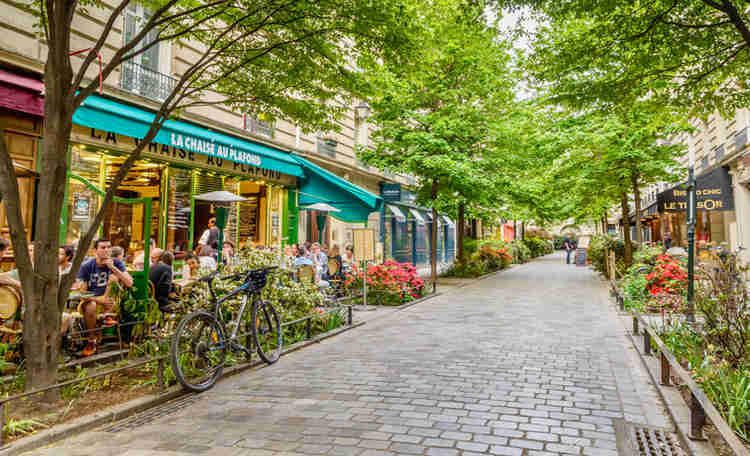
Tips For Visiting the Marais
Here are some must know tips for spending a day discovering the best things to do in the Marais.
1. How To Get To the Marais
Depending on where you’re staying, you can just walk to the Marais. If you are staying further afield, take the metro to Saint-Paul or Chemin Vert metro stations and start your visit on the Place des Vosges.
The best way to see the Marais, and all its enchanting nooks and crannies, is on foot.
To make sure you don’t miss any, you may want to book a guided walking tour or a walking + tasting tour with Secret foods.
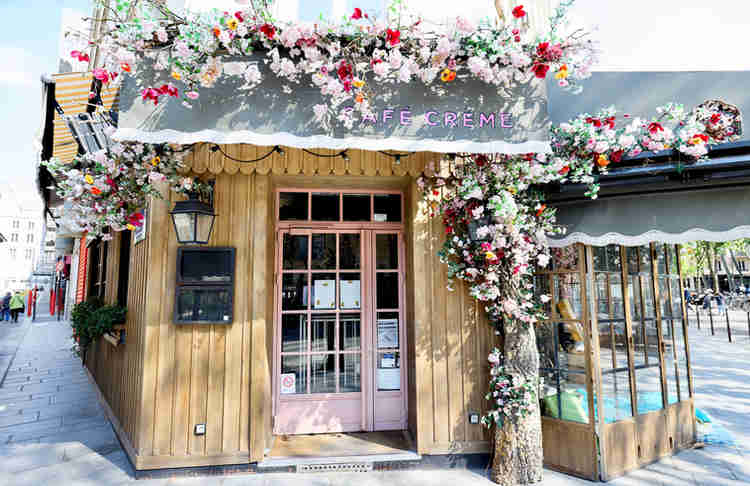
2. Where To Eat in the Marais
1. You can find the best falafel in Paris at L’As du Fallafel on Rue des Rosiers. You can’t miss it. There’s always a long line of fans.
3. If you want to hang out at an Instagrammable cafe, try Cafe Creme, the Broken Arm, Cafe Ju, Gamins, or La Favorite.
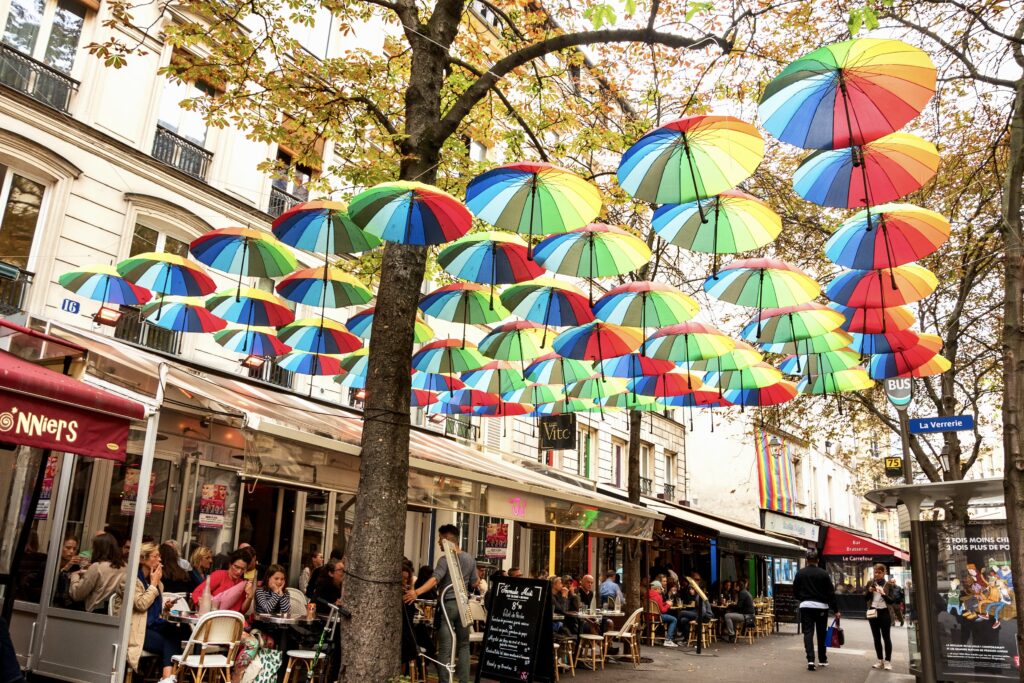
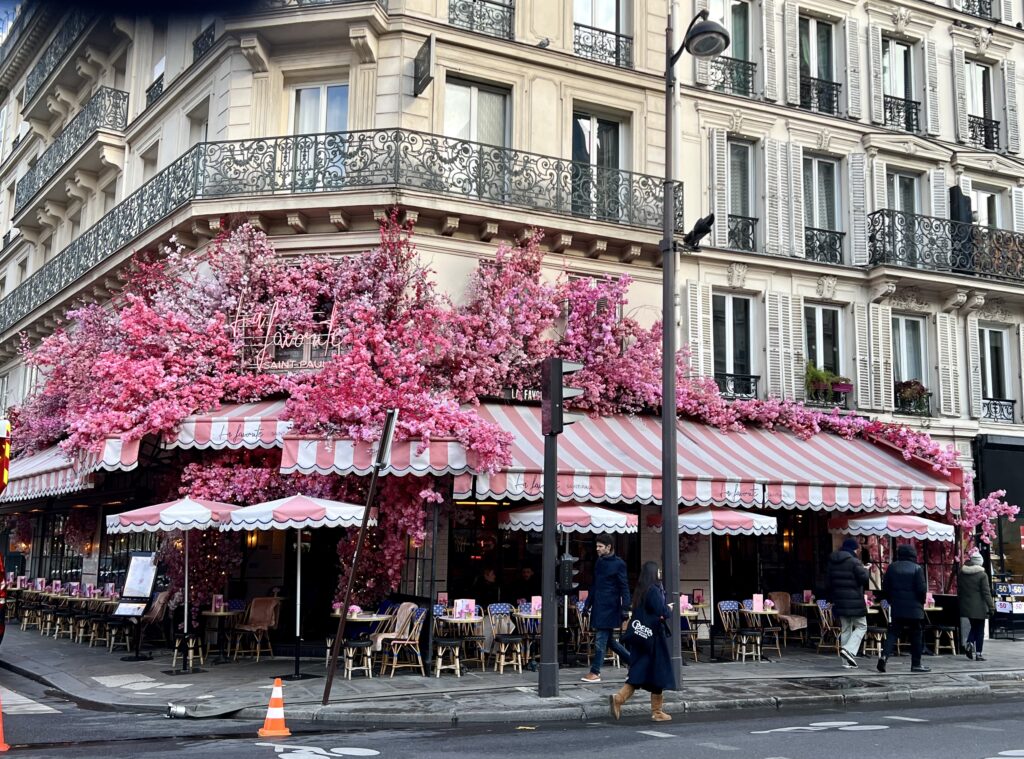
4. If you’re a vegan, head to HANK Burger.
5. If you’re craving a gelato, try Pozzetto on Rue du Roi de Sicile.
6. For a romantic and intimate restaurant, I recommend L’Alivi on Rue de Roe de Sicile.
7. For a cocktail with views to finish your day, head to Le Perchoir. This tony bar occupies the top floor of BHV department store on Rue de la Verrerie.
8. For dinner, reserve at Les Chouettes, Grand Coeur, Carbón, or L’Alivi.
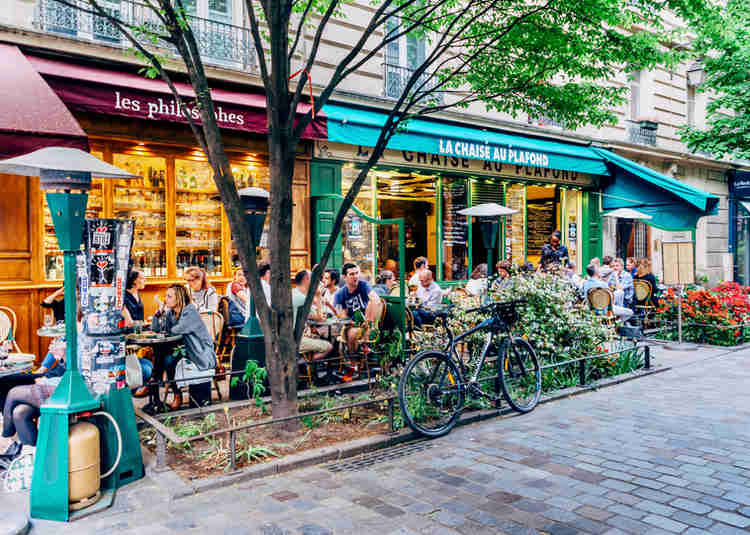
3. Where To Stay in the Marais
Want to stay in the Marais? The Marais doesn’t have the grand and over-the-top hotels of central Paris, with the exception of the incredible Pavillon de la Reine on Place des Vosges.
But it does have a swathe of quiet boutique hotels, including:
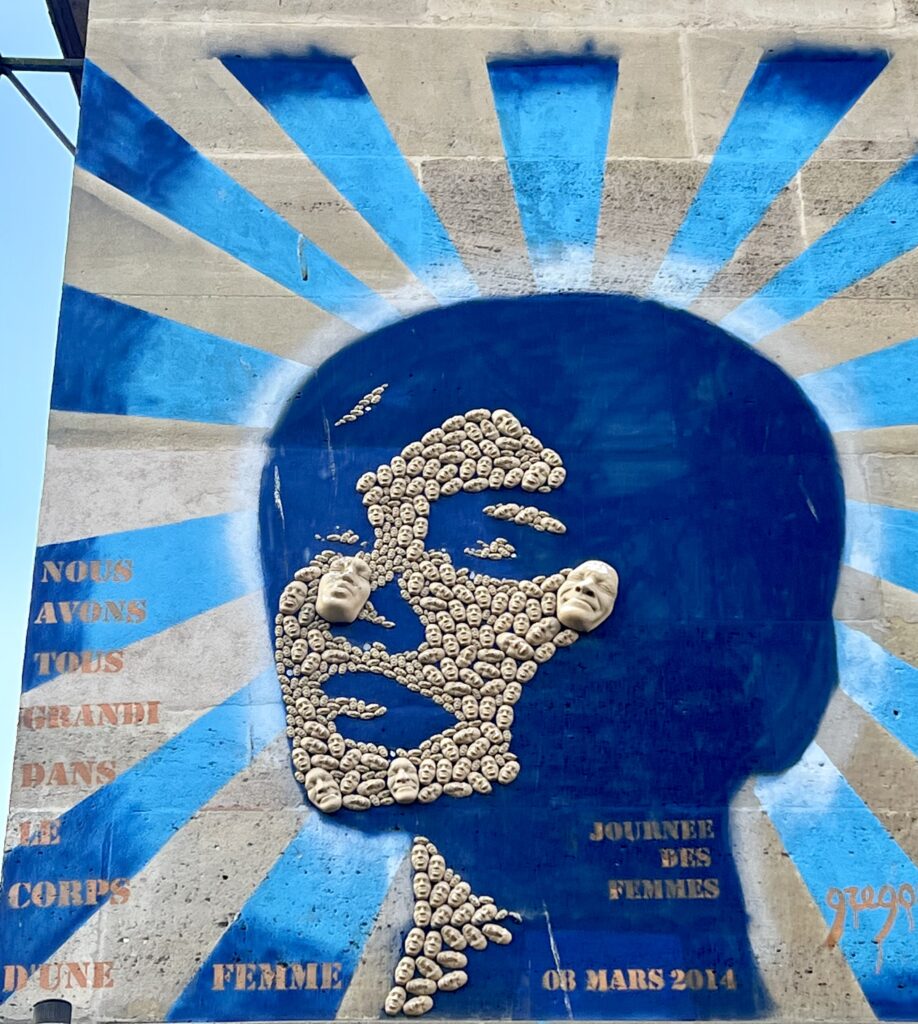
I hope you’ve enjoyed my guide to the best things to do in the Marais. You may enjoy these other Paris travel guides:
- 5 day itinerary for Paris
- 3 day itinerary for Paris
- 2 day itinerary for Paris
- Hidden gems in Paris
- Guide To Montmartre
- Guide To the Latin Quarter
- Best Museums in Paris
- Louvre Survival Tips
- Guide To the Musee d’Orsay
- Secret Day Trips Rrom Paris
- Tips For Visiting Paris Like a Local
If you’d like explore the Marais neighborhood of Paris, pin it for later.

